Bursting forth from the Webway, the forces of the Asuryani have finally arrived in 9th edition proper – and they’ve brought friends. The brand new Aeldari codex covers not only the Craftworld Eldar, but also the cryptic Harlequins and grim Ynnari, making it one of the largest and deepest codexes we’ve seen this edition.
This article is one of four that we’ll be publishing today, taking a deeper look at the Asuryani in all their glory. If you’re looking for more details about the Harlequins or Ynnari, or just want a high level look at the key takeaways, head back to the initial Overview review here.
Just before we start, we’d like to thank Games Workshop for providing us with a review copy of this book, and with some of the models you’ll see pictured within the article.
What’s in this Book For the Asuryani?
- Lore for the Asuryani, covering the fall of the Eldar, the Craftworlds and their notable champions.
- Rules for constructing an Asuryani army, including one that draws on the strengths of the Ynnari (which we’ll look at later today).
- A revamped set of Aspect Powers, allowing you to turn your Exarchs into masterful killers.
- Crusade Rules, including proper rules support for the Paths of the Eldar for the first time.
- Three disciplines of Psychic Powers available to Craftworld Psykers (in addition to those for the Ynnari and Harlequins).
- All the stratagems, traits and relics you’d expect from a 9th Edition codex.
- Datasheets for all Asuryani units.
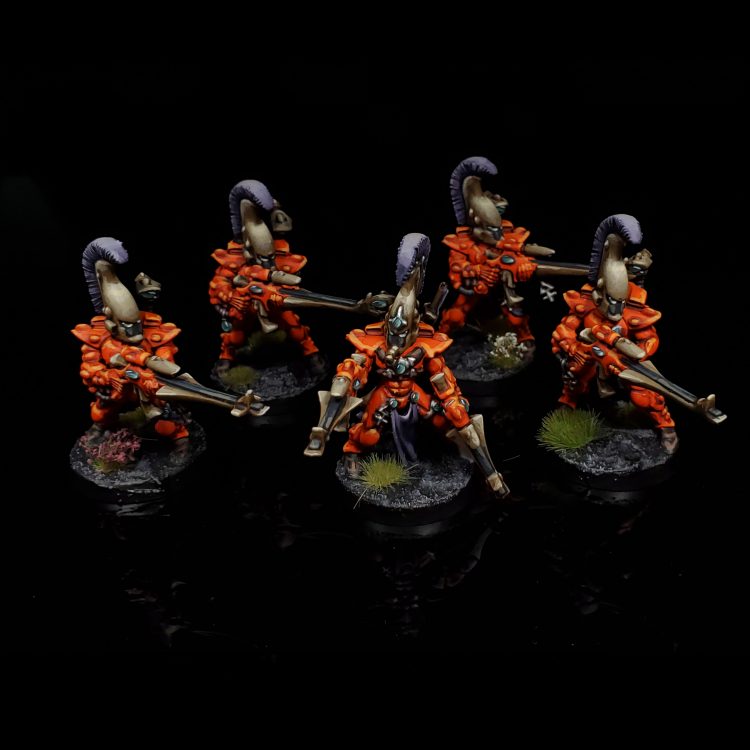
The Rules
Building Armies
- Standard-issue detachment rules (the newest version as seen on Tau), so only one Craftworld per list.
- Traveling Players allows you to bring a Harlequin Patrol with no penalty, with some deeper integration that gives you wide flexibility in accessing things like Warlord traits
- Ynnari work like a special Craftworld, though they have some unique rules to allow them to include Drukhari and Harlequins units along with Craftworlds ones.
- Only one Autarch per detachment, no Craftworld trait for the Avatar.
Nothing too surprising for anyone familiar with recent 9th Edition Codexes – Eldar get the standard ObSec for their troops, standard 9th Edition limitation on only having one “general” tier character in each detachment, and the new standard version of selecting a subfaction, where you have to pick one for your entire army and stick to it.
Two Eldar-specific points here. YNNARI is now essentially a <Craftworld> selection, and indeed all the Named Characters from the Reborn have the Asuryani keyword, so your starting point for a list with them is as a special flavour of Craftworlds (though there’s some depths we’ll look at in their article).
The other more interesting one is the Traveling Players rule, allowing you to bring a Harlequin Patrol alongside your Asuryani without switching off rules like Strands of Fate. That’s cool and has definite uses, but what’s surprising is that the integration between the armies is perhaps more sweeping than expected – quite a few Stratagems now “overlap” between the Asuryani and Harlequins, and you get more flexibility with Relics and Warlord traits than you’d maybe expect in soup-averse 9th. Specifically, if your Warlord is either Harlequins or Asuryani, you can give your free relic to a unit from either faction, and unlock the extra Warlord Trait stratagem to use on either as well. In addition to that, the Asuryani Secondaries don’t require you to have an Asuryani Warlord, just for your whole army to be Asuryani, which Traveling Players explicitly bypasses.
What that adds up to is that if you decide you want your Warlord in a Harlequins Patrol, doing so is surprisingly plausible – you lose the ability to buy additional Craftworld Relics, and access to Craftworld-specific relics, but not much else – and this is something you may well want to do, as we’ll look at in the final article today.
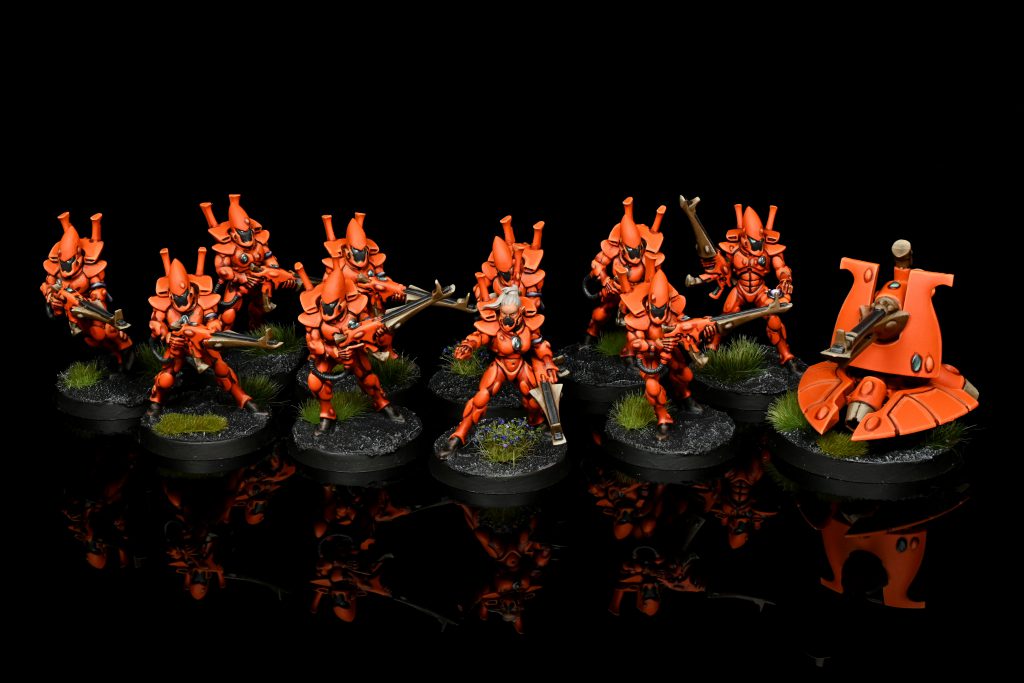
Army-wide Rules
- Battle Focus adds mobility, but with enough constraints that it’s not army-defining.
- Strands of Fate provides you with powerful certainty, but will occasionally critically betray you.
- Shurikens get spicy (extra -2AP) on 6s to wound.
- Standard versions of Deep Strike and Scout Deploy are included.
Both the Eldar standout special rules have been previewed on Warhammer Community, and both look decent.
Many Infantry and Biker units in the book have the Battle Focus rule on their datasheet, giving them two mobility options. They can either Advance and Shoot Pistol and Assault weapons or if they did not Advance or Fall Back, make a d6” Normal Move after shooting. The first half of this is essentially what Battle Focus is now, and is good for mobility, but held back a little by the Remain Stationary bit not working out of a Transport, which Eldar need to make quite a bit of use of.
The latter part is…definitely good, but has a couple of restrictions that mean it’s maybe not as strong as anticipated. The key thing here is that there’s an extra rule not shown on WarCom – if any part of a Battle Focus move crosses Area Terrain, you subtract 3” from the move (though you do ignore any Difficult Terrain penalties). That means that if you need to traverse any terrain, you need to roll a 4+ to move at all, giving a risk of getting caught high and dry, especially on tournament boards that tend to favour Area Terrain over Obstacles. Don’t get us wrong, this ability is still going to do plenty of work, as even just being able to shoot an enemy unit off an objective then move onto it for free is a very powerful move, but the Area Terrain limitation is extremely real, especially as you can’t use Strands of Fate to manipulate the dice.
It’s also important to note that you are specifically not allowed to use Battle Focus to embark into a Transport – so you can’t jump your Fire Dragons out, unload on something, and then duck back into safety. The Stratagem-powered version of this was erratad out for most of 8th edition before briefly re-appearing in 9th, and now it’s finally dead (though, as we’ll see later on, not completely – Fire and Fade still exists, and while it has the same rider for Craftworlds units, Harlequins can use it to vault back into the boat!).

Speaking of Strands of Fate – this absolutely rules, and turns where you get good rolls on this are going to feel incredible. This new mechanic has you roll six dice at the start of each battle round, and you get to keep a number of them based on the game size (4 in Strike Force games). Each die result corresponds to a type of roll you can spend that die on later in the round to automatically generate a 6 result for a single die – no roll required. These six rolls are:
- Advance
- Charge
- Psychic Test
- Hit Roll
- Wound Roll
- Saving Throw
We think your priority here is generally as follows:
- Keep a dice for a Charge if you have a Deep Strike unit coming in.
- Keep a dice for a Psychic Test if you have a must-cast power, usually Doom or Will of Asuryan.
- Keep a dice for an Advance if your Banshees are about to go mess someone up.
- Stash hits or wounds if you’re about to go big with an “exploding” or mortals on 6s effect, or shoot Fire Prisms.
- Keep as many Saves as possible in all other situations.
Do that, don’t roll all 1s, and things look very good indeed. Asuryani are relatively fragile, so having pocket auto-saves is extremely good, but with plenty of D3+3 damage weaponry added to the mix, sometimes being able to fly behind someone and blast an automatic hit and wound through is going to be excellent as well. Automatic 6s are also nasty as hell on both Asurmen and Karandras, threatening to just cold detonate enemy units in a flurry of Mortal Wounds, so useful to have around. The other effects all have their places, and the good thing here is that you’ll often know when they’re going to matter, and can hold dice accordingly. Notably, Doom and Will of Asuryan both become unfailable if you’re willing to throw a Strands dice at them, and these are the two powers where an untimely failure risks just being game over. Get ready to enjoy this one a lot. The only mild critique of it is that, when you occasionally do roll all 1s, it can feel like something of a bad beat, and an easy fix for this would have been to allow 1s to be used on Battle Focus moves too, but I suspect we’ll discover as we play games that this one is plenty good enough already.
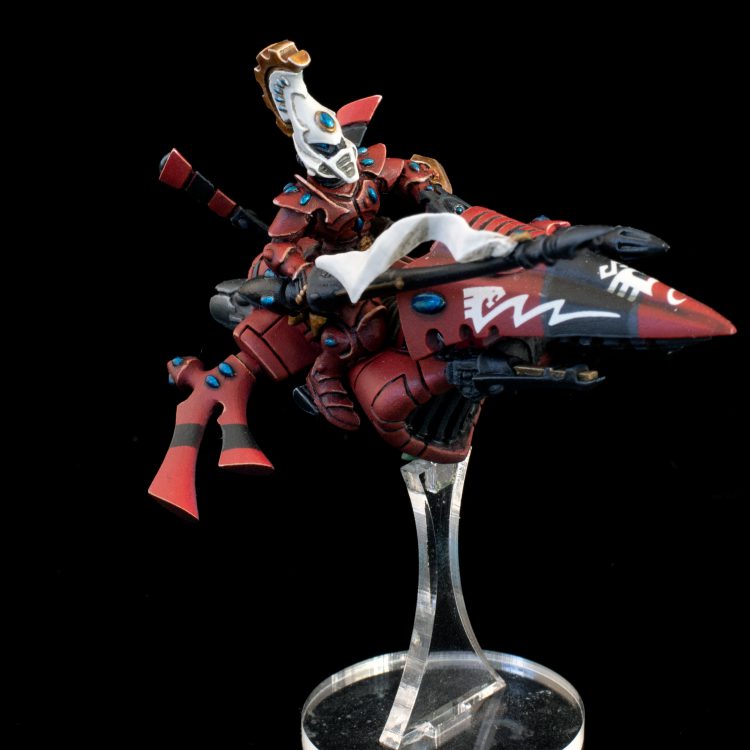
Subfactions – The Craftworlds
- Substantial improvements across the board in named Craftworlds compared to 8th edition.
- Ulthwe and Biel-Tan stand out as the best competitive options among the named Craftworlds, with Alaitoc maybe getting there as well.
- Strong theme support from Iyanden and Saim-Hann, ideal for smaller games.
- Clutch of powerful-looking picks among the custom options.
A triumphant return for actually picking Named Craftworlds here, as two of the options are very good. Extremely not coincidentally, they are the two that get half of the “one re-roll per unit” effect each – Biel-Tan on hits, Ulthwe on wounds.
Both are a lot deeper than that though, and the reason they stand out is how broad a package they give you. Ulthwe’s trait has a mighty three further effects – an army-wide 6+ invulnerable save, a 5+ to ignore Mortal Wounds, and +1 to each Psyker’s first cast each turn. That’s a lot of power, and the 6+ invulnerable is sneakily even better than it would normally be – similar to Acts of Faith in Sisters, it means you can always burn a Strands of Fate auto-6 to pass a save, even if your tank is being hit with some AP-5 nonsense – well ok, not a Railgun, but everything else. All the rest of their stuff is strong too – the Warlord Trait lets you keep an extra Strands of Fate dice each turn (almost always great), the Ghosthelm of Alishazier is interesting because it both lets you get undeniable Powers off on an unmodified 9+ (which remember is 66% of the time if you’re burning Strands on a key effect), and also gives you a free pick from the Runes of Fortune. This latter bit is more impactful than it sounds, since as well as just being an extra power it also provides a way to get a pick from this lore onto Warlocks, which you can no longer normally do.
Finally, the Discipline of the Black Guardians Stratagem still provides you with +1 to hit on a GUARDIAN unit, and while Guardian Troops are maybe 1pt too pricey across the board, Ulthwe is one of the more plausible places to use them. GUARDIAN is quite a broad keyword, too; this can also be used on Windriders and Support Weapons, both of which look like they have real applications. Ulthwe looks like an interesting place to build lists with Webway gates and that rely on having lots of casts kicking around (Eldrad is also still very good), and generally looks like it provides the best competitive support for slightly heavier stuff like Wraiths and the Avatar.
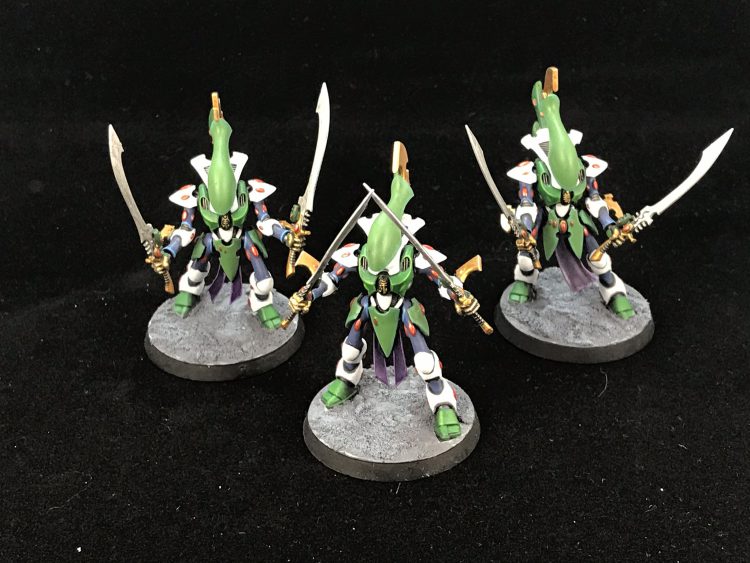
Biel-Tan’s second trait half is maybe a bit more restrained than Ulthwe’s, but is still very good – they treat 1s and 2s on Advances and Battle Focus moves as 3, making them very mobile. This doesn’t, sadly, get them over the magic number of being able to guarantee some movement in Area Terrain, but 3” guaranteed is enough that you can start planning to strafe gracefully behind some terrain after cracking off shots like some sort of 00s FPS protagonist. It also makes investing in Vectored Engines for their Vehicles much more of a sure bet – no chance of just rolling a 1 and getting nothing out of your upgrade, and again enough movement that you can line up the narrowest possible shooting angle, then zip 3” backwards to dodge reprisals.
Building on top of this extra mobility, Biel-Tan get one of the best relics in the book in the Spirit Stone of Anath’lan, granting an extra known power and one cast re-roll a turn (which Farseers no longer get natively). Any sort of conventional combined arms list is likely to want access to Guide, Doom and Will of Asuryan, and this (in combination with Unparalleled Mastery) lets you tick this all off on a single Farseer, which is excellent. Their Stratagem also rules, giving exploding 6s when shooting or fighting with Aspect Warriors, and this makes all the good Aspects wildly better in this faction, especially Shining Spears, who can get some of their old-Ynnari energy back by deleting units in multiple phases. Finally, their Warlord Trait is one that would be exceptional in any other army, and here is still very good. Natural Leader gives you the option of giving full hit re-rolls to a CORE or CHARACTER unit in range, though only lasting till the end of the turn; it’s a strong ability, but Eldar will often be bringing their units in from Deep Strike or from Transports, removing a window to apply this. It can still provide strong support to Shining Spears, and is a helpful force multiplier once battle is joined, so will still see use (and can be a way to tick off the Guide requirement if you can only squeeze two Farseer casts in). Biel-Tan looks like it provides the strongest support for a conventional combined arms Craftworlds force – it does something to help almost everything in the book, and helps ensure that the punches you throw connect.
Alaitoc, Iyanden and Saim-Hann all have good stuff going for them, especially if you’re aligned to their themes, they just don’t look quite as broadly competitive as the first two. Alaitoc are, as ever, the Sneaky Ones, and their new trait is pretty decent – everyone gets Light Cover outside 12”, and INFANTRY and BIKER units that are entirely on or within terrain and outside 12” get Dense Cover as well. Giving some modicum of protection against smart missile systems is pretty relevant in the current metagame (as they don’t ignore Dense) so you certainly won’t hate having it. As a final bonus, you also ignore any Movement Characteristic or Advance roll penalties, which isn’t super relevant (it carefully does not override the Battle Focus Area terrain penalty) but is pure upside. Alaitoc’s toolset provides various benefits to Rangers, all at least somewhat interesting, and also lets you make an INFANTRY CHARACTER unshootable unless they’re both within 12” and the closest target – certainly not bad if you just want a foot Farseer or Warlock chilling out on a home objective all game. The Warlord Trait is also notable for providing Action and Shoot to an Infantry unit (along with the ability to redeploy Rangers), which can help this army cover Action secondaries. While not as obviously powerful as Ulthwe or Biel-Tan, every part of the army’s kit does look like it could have a real application in competitive play, so it’s plausible that this sees use.
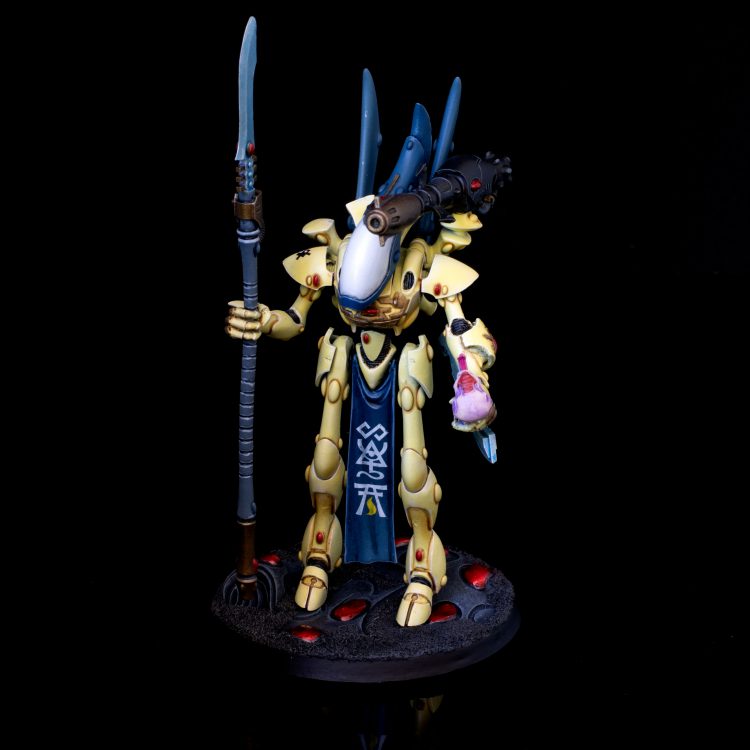
Iyanden gives you +1 to Combat Attrition, which is meh, and lets you reduce incoming AP-1 or -2 by 1, which obviously rules – it’s another thing that provides some modicum of protection in Tau land, and should be decent in mirror matches. The Psytronome of Iyanden stands out from the rest of the kit, giving a Command phase effect that both adds an attack to a Wraith unit, and grants Battle Focus for Wraithguard. If you decide to go in on a big brick of Wraithguard or Blades this is extremely handy, and just boosting a Wraithlord isn’t bad.
Last up, Saim-Hann get charges boosts for their trait, both a re-roll for charges and the ability to Fall Back and charge, neither of which are bad, but you can manipulate both elsewhere in this book and they aren’t things you need all the time. What you can do with this Craftworld (quite appropriately) is create an Autarch from hell, and ensure some Shining Spears can keep up with him. The Warlord Trait and Relic both boost up a model’s combat prowess, and combine to mean that either a laser lance or star glaive autarch will be swinging with a cool six S7 D3 attacks on the charge, while Warriors of the Raging Winds still gives the sweet Advance and Charge for Bikers.
Generally, it feels like both Saim-Hann and Iyanden will be much more interesting in Incursion style games – if you want to centre your army around the units they support then they’ll feel very cool, but they don’t bring the breadth of impact you want for Strike Force.
Looking over at Custom (here “Far-Flung”) Craftworlds, Eldar eschew the various complex mechanics for this that we’ve seen recently for the old-school “pick two effects”, and there’s some good ones. Standouts are probably:
- Hail of Doom – automatic wounds on 6s to hit with Shurikens, which count as 6s to wound as well (so trigger extra Shuriken AP).
- Hunters of Ancient Relics – Action and Shoot army-wide, good in a Windrider-heavy list with the above.
- Mobile Fighters – +1 to wound when making an attack after getting out of a Transport. Allows for a terrifying alpha strike, especially in combination with Falcons.
- Various efficiency boosts – you’ve got options for single hit re-roll, single wound re-roll, ignore Light Cover, the Ulthwe 6++ and 5+ ignore Mortals, and Light Cover outside 12”, any of which could be combined with one of the above to help build a complete package.
There are also some themed options that could work for a specific list, with Heroic Interventions for Wraith units via Wrath of the Dead probably being the standout there. What we’ve found when building lists is that ensuring you can cover Action secondaries can be somewhat challenging, so Hunters has some real applications, and both Hail of Doom and Mobile Fighters can give you some big damage spikes. As ever, these are competing with the fact that the best named Craftworlds get a broader package of stuff, but it looks like there are plausible lists built around these traits too.

Stratagems
- “Standard” suite of Eldar defensive and mobility tricks, which are shared with Harlequins.
- Phantasm lets you pull stuff to Strategic Reserves as well as redeploying, exceptional with the Webway Gate.
- Powerful psychic support makes Farseers highly flexible.
- Some big splashy tricks for shurikens, Dire Avengers, Fire Prisms and Phoenix Lords.
The Stratagem section here is, in some ways, not that surprising but it’s also extremely good, and encourages you to cram as many CP as you can into your list. First up, as expected from an Eldar book, you have all your fun standard speedy tricks – Lightning Fast, Fire and Fade, Feigned Retreat and the like, all re-calibrated to the same costs as the Drukhari, and all a core part of your gameplay. The only big note here is that Fire and Fade now doesn’t let you get onto a Transport (unless you’re a Harlequin, sneaky clowns), so the old untouchable Reapers are gone.
Specific to the Asuryani on top of this you get Matchless Agility, which lets you fix a Battle Focus dice to a 6 (acting as a cheaper and/or second Fire and Fade) and Phantasm. Phantasm looks critically important now, letting you redeploy up to three units, including pulling any or all of them into Strategic Reserves for free. It lets you be very muscular with Striking Scorpions while having a backup plan, gives you huge flexibility if you’re packing a Webway Gate, and can be excellent if you want to run single powerful models like the Avatar or a Crimson Hunter into a hostile metagame. This was a crucial Craftworlds Stratagem throughout 8th edition, and the new version is better than ever. Forewarned also stays, slightly more limited than it was (the target has to be within 18”) but still easily the best intercept shooting in the game.
Moving on to Psychic might, Farseers get a whole panoply of extra tricks – extra casts, one cast after performing a Psychic Action (hugely useful in the Nachmund pack) and possibly the spiciest orbital strike equivalent in the game in Eldritch Storm. This is very expensive at 3CP, but is genuinely sometimes going to be worth it – you pick a point within 24” of a Farseer in your Command Phase, can perform a Psychic Action to empower it with any nearby Farseers, then it detonates in your shooting phase – so unlike most other newer ones, the opponent gets no time to dodge it. When it goes off, it does d3 Mortals (+1 for each time it was empowered) to units within 6” on an eye-watering 2+ (with a penalty for INFANTRY CHARACTERs), meaning if your opponent forms a battle pile this is serious stuff (and gets even wilder if you have multiple Farseers who can spare the cast – and of course as a psychic action one of them can still cast a regular power too with the aforementioned Stratagem). Expensive enough that you don’t do it every game, but an actual real tool for the back pocket.
The last big category to be aware of here are some huge spiky tricks for specific units. Anything with shurikens is up first, unleashing Bladestorm for exploding 6s, something you’ll want a lot, and if the opponent makes the mistake of killing a single Dire Avenger from a big unit, they can go wild with this by also firing again at the end of the phase with Avengers of Asuryan. If you’ve brought a Phoenix Lord you’re very likely to end up slamming The Phoenix Reborn to try and get them back up on a 4+, incredibly good when it works as they’re all ObSec. Finally, Fire Prisms keep their signature move of Linked Fire. This allows you to pick a Prism, and then one or two other Prisms within 12” of it and visible to your model. The others you pick can’t shoot their prism cannons this turn, but the first one gets 2 extra attacks for each other Fire Prism when using its focused lance profile – the “big” shots, ordinarily Heavy 2 at a mighty S14 AP-5 damage 3d3 – and also gets to ignore invulnerable saves. This is a powerful trick to have, since you can stick Vectored Engines on your Prisms to allow them to make a once per game Battle Focus move; played correctly you can rotate which one is in LoS, link fire before moving it back out of sight, and then repeat the trick with another the next turn. That’s great in itself, and the other big deal about this is that it means two Fire Prisms is enough to get a big impact, whereas before you needed three to really reach the value you wanted.
A few more units get their own toys, and you get the expected set of 9th Edition upgrade stratagems for extra Warlord traits and relics too, plus a couple of unique ones – one that hands out Exarch Relics (more on that in the Relics section) and a redesigned Seer Council which turns a multi-model Warlock unit into Bodyguards for a Farseer, and also gives +1 to cast. This is theoretically great in some metagames, but absolutely not the one we live in here in 2022, where they will be immediately and violently killed with smart missiles.
All told – these Stratagems rule, using them well will be key to winning games, try to bring CP and lots of it. As mentioned previously, a surprising number of these are shared with Harlequins (some of them very carefully so, so that you can’t accidentally lock yourself out of things like extra Warlord traits), and while we haven’t covered that in any depth here we will talk about the implications for the clowns and for Aeldari soup lists in their respective articles.
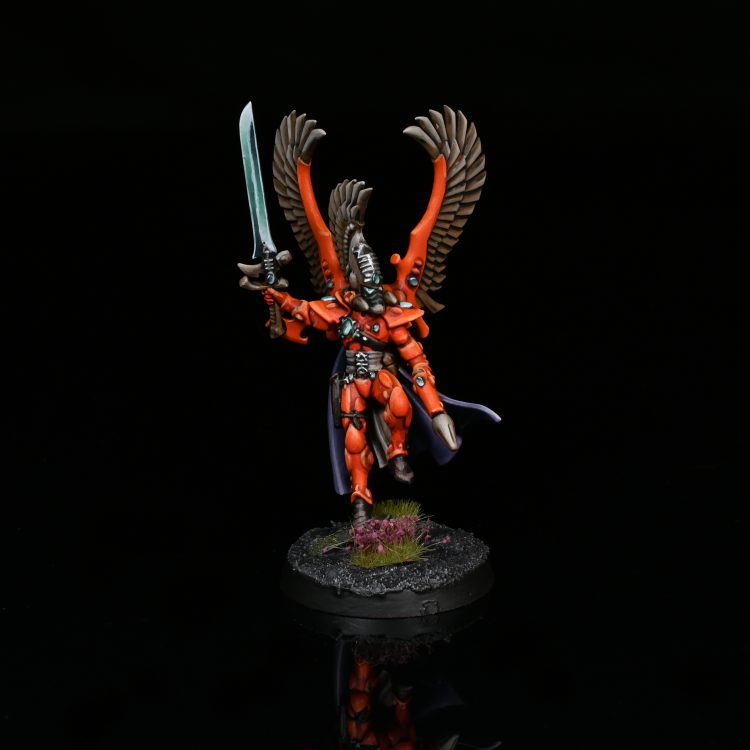
Warlord Traits
- Seer of the Shifting Vector is an extremely easy general pick for good CP regen.
- Several potent Herohammer tools in Walker of Many Paths and Fate’s Messenger..
- Useful utility for a Farseer in Falcon’s Swiftness.
The Craftworld Warlord Traits in 8th were notoriously terrible, and luckily this list represents a significant improvement. Realistically, this army is so CP-hungry that a lot of lists are just going to default to Seer of the Shifting Vector, which is a strong version of CP regen (get one back on a 6 for each Command Point either you or your opponent spends) and thus both good as your free pick and very often worth it as a paid one. If you want to create a Character who can go out murdering, either Walker of Many Paths or Fate’s Messenger are good – the former gives one re-roll for a hit, wound or damage roll per turn (nasty on a foot Autarch with a fusion gun), while the latter lets you change the damage of one failed save per turn to zero, great for keeping a bike Autarch in the game for longer. The final strong one looks like Falcon’s Swiftness, which grants 2” extra movement, allows ignoring difficult terrain, and an automatic 6” Battle Focus. This seems like it could be powerful on a Bike Psyker, as it lets them close within 18” to guarantee landing a power, shoot their shurikens, and then move back to safety.
Neither of the other two look terrible, but neither feels like they do enough to get the nod over these four (or some of the Craftworld-specific options). It’s nice to have good choices at last though!

Relics
- Sunstorm.
- Sunstorm.
- Pick Sunstorm.
- Other stuff exists, technically – Phoenix Gem and Faolchu’s Wing both get better.
- Exarchs get relics too – some are OK.
One overwhelming standout here, and the list above has probably helped you figure out which – it’s Sunstorm. It’s a relic jetbike that gives +4” Movement and Objective Secured, which is just incredible on a Bike Autarch, and perfectly fine on a Farseer Skyrunner too. Pick it early, pick it often. Also good are old favourites the Phoenix Gem and Faolchu’s Wing. The Gem now just lets you get back up on a 2+ at the end of the phase once per game, generally much more reliable in providing durability than the old version, while the Wing still provides a 12” FLY move for INFANTRY (so great on a cheap Farseer), and has the added value that you get to bomb one unit you move over for d3 MWs at the end of your movement phase on a 2+, adding some extra defensive heft. For new toys you might use, both the Aegis of Eldanesh and the Weeping Stones seem fine – the former gives an Autarch -1D and a 2+ save, which won’t get the nod over Sunstorm for a biker but is spicy on a foot version who wants to be aggressive with a Banshee Mask, while the Weeping Stones let you roll one extra dice for Strands each turn, helping lock in what you need. Hard to tell whether it’s quite worth buying (probably not, is our guess) but it’s an OK effect.
There are also a bunch of relic weapons, and honestly you probably just don’t take these – they’re better than they were in 8th, generally, but none of them are transformational to a unit’s capabilities like some of the above are.
Also getting in on the action are Exarchs – instead of taking one normal relic, you can pick two of these to hand out to your Aspect Warrior units, and there’s also a Stratagem to buy two more. These vary wildly in power level, in general being a bit on the low side, but Khaine’s Lance for Shining Spears, Cronescream for Banshees and the Phoenix Plume for Hawks all look reasonable, with the Spider’s Bite also maybe sneaking in on an upgraded Spider Exarch if you have one. Khaine’s Lance rules – when you charge with the unit, you pick one engaged enemy unit, roll a d6, and on a 4+ they take d3 MWs and Fight Last. It’s a bit swingy, but it gives you something to fall back on if you really need a clutch turn. Cronescream is just straight Mortals on a charge (once per game) but a good version of that – it triggers on a 2+, and adds a Mortal for each time the unit has charged this game. Just a baseline of usually getting d3+1 mortals really helps ensure the Banshees kill what they’re hunting, especially important if you’re picking Wrath of Khaine as a Secondary. The Phoenix Plume just makes Hawks very tough, giving the Exarch a 4+ invulnerable save and the whole unit a 5+ to ignore wounds, leaving them far stickier than most infantry in the army (though maybe still not proportional to their price tag). Finally, the Bite is a very heavily upgraded set of Powerblades that means the Spider Exarch is actually a meaningful melee threat – fine if you have the slot. Not certain what to make of these overall – some are definitely decent, and getting two at a time does help, but paying a CP to get them is a steep price in this book.
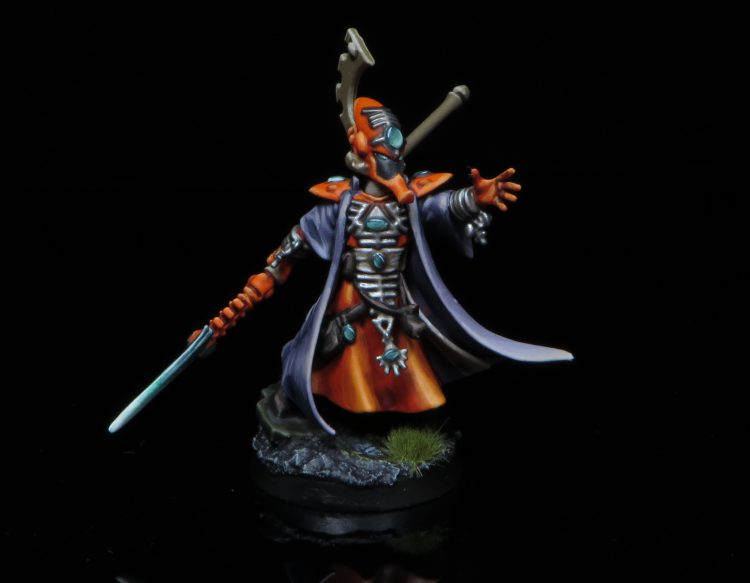
Psychic Powers
- Farseer Runes of Fate Powers rule harder than ever, with Guide now working on melee, and Will of Asuryan now being an exceptionally potent tool.
- Warlock Runes of Battle Powers catch some pretty heavy nerfs and end up looking fairly weak, though Embolden/Horrify gets a huge upgrade.
- Runes of Fortune are very hard to get into lists, but some armies will need Ghostwalk.
The Asuryani are famed for their psychic might, and that’s reflected by having a lot of powers to choose from. Farseers can pick two powers from the Runes of Fate and/or the Runes of Fortune, Warlocks get one from the Runes of Battle (or more for bigger units) while Spiritseers can have either a Runes of Battle power or a Runes of Fortune choice.
Runes of Fate powers are going to be the engine that drives Craftworld lists, so kind of same as it ever was. They can all affect CRAFTWORLD CORE or CRAFTWORLD CHARACTER units, which makes them broader than some similar options elsewhere, and all have a quirky new mechanic where they have a base range of 18”, and on a high cast (the threshold varies) they either go up to 24” range, or get more powerful, in the case of Mind War.
Guide and Doom remain your key force multipliers here. Doom does what it always has (with the added keyword restrictions), and anything it loses from no longer working as broadly it gains back from how much better your options for barraging the enemy with shurikens are. Guide also gets a huge uplift, now working on melee attacks as well, letting you turn your key Aspect Warriors into blending machines.
Joining them in the pantheon of key powers is Will of Asuryan, winner of the Most Improved Psychic Power 2022 Award. It now provides a gigantic buff for friendly units, making them ObSec, immune to Morale, and able to shoot while performing an Action without failing it. We’ve found that it’s hard to slot in enough throwaway units to reliably get Retrieve Nachmund Data on lockdown with this book, but this gives you another way past that, and is particularly good on shuriken catapult Windriders, probably the first Biker unit that’s going to see heavy Action applications since Nachmund arrived.
Fortune, Executioner and Mind War still largely do what they’ve always done with minor tweaking – Fortune lets a unit ignore wounds on a 5+, good on the Avatar or a big bomb unit, Executioner is a very powerful Witchfire power that gets a bit of a targeting sidegrade (no longer hitting Characters with nine or fewer wounds at all, but now otherwise being freely targetable within 18”), and Mind War remains a funny but not actually good way to construct hilarious hypothetical combos to blow opposing Characters’ heads off.

Over in Runes of Battle, things are honestly a bit grim – all three standout 8th Edition tricks have been heavily nerfed. Protect no longer boosts invulnerable saves, which is probably fair enough, but Jinx no longer impacting enemy invulnerables hurts a lot in a metagame where all the top armies have them on almost everything that matters. Quicken has also been given an absolute kicking – using it on a unit now stops them shooting or charging afterwards, leaving applications incredibly niche. Higher points here are Embolden and Horrify, which now apply known excellent effects Fight First or Fight Last respectively (and unlike some of these Embolden can go on friendly Characters too); also good is Empower/Enhance, which both benefit from having actual good melee stuff beyond Shining Spears to work with. Realistically, many lists are still going to want Protect kicking around (maybe on a caster who’ll do Actions most of the time), and melee-heavy builds will want Embolden/Horrify in play. There’s also some new potential in Conceal, as this now provides Light Cover rather than -1 to hit, which means if you can squeeze two casters into your list you can stack +2 to saves against shooting onto a powerful unit like Shining Spears or Wraithguard, which could definitely be something.
Runes of Fortune are weird – their signature mechanic of swapping in for Smite is gone, so now you usually have to give up a known Farseer power to get access to them and that’s a steep price. The one here that’s still probably worth it sometimes is Ghostwalk, which as in the past grants +2 to charges, with the expected restriction of targeting a CORE or CHARACTER unit. This can combine with a Strands dice for a guaranteed 9” charge, and I strongly suspect I do not have to explain why that’s good. The other one that’s a maybe is Fateful Divergence, which just flat gives you a Command Point. Here, the play might be to bring a Corsair Voidscarred unit, whose in-squad Psyker can take these, and use them as a backfield/CP farm unit (if, for some reason, you don’t have Seer of the Shifting Vector). Beyond that, it’s hard to see these getting the nod that often – I guess if you want the cheapest possible HQ, a Spiritseer farming CP with Fateful would also work.
All this combines to mean Farseers are vitally, vitally important and good news on that front – they’re also cheaper. Take at least one in every list, sometimes two. Warlocks, on the other hand, are now more of a sometimes treat, but there are definite applications for some of the powers, and having a dedicated Psychic Action caster with a neat trick up their sleeves isn’t terrible.
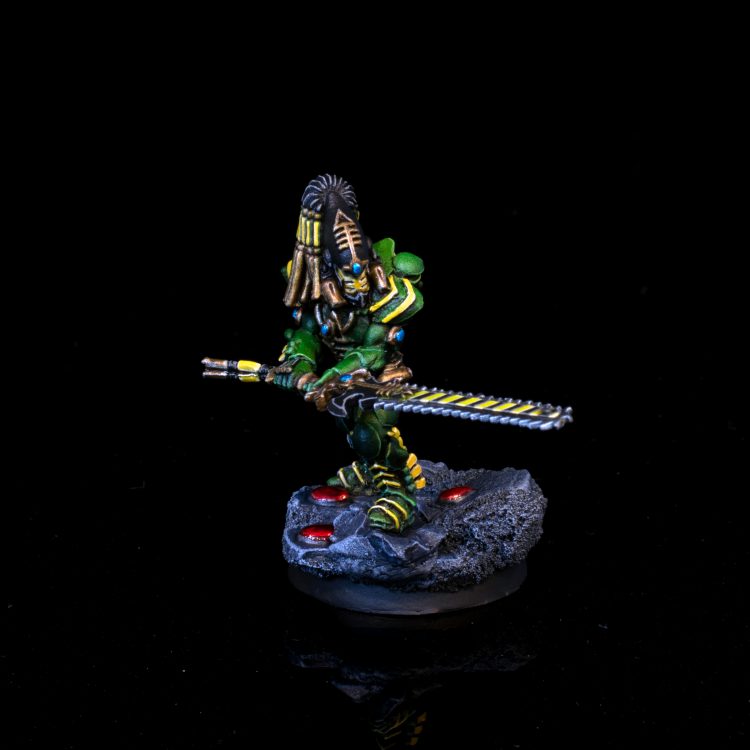
Exarch Powers
- Upgrade Exarchs to give them extra stats and special abilities for points.
- One very good choice each for melee Aspects and Dire Avengers.
- Quite a lot that seem a bit over-pointed elsewhere.
Exarch powers are now the Asuryani’s paid upgrade option, with three choices for each Exarch shrine that you can buy for points. Same deal as always with these – each unit can only have one, each one can only be included in your army once, and an extra rider here that you can only ever upgrade one Crimson Hunter to be an Exarch, because they are very much on the naughty list after what they did in 8th Edition.
When you upgrade an Exarch you get both some stat boosts for the Exarch and a special ability. The stat boosts are a very nice extra – shooty models go to BS2+, melee ones (plus Warp Spiders for some reason) get +1A, and all flavours get +1W. The weird exception is Dire Avengers, who only get an extra wound – apparently striking a perfect balance between attack and defence makes you mediocre at everything. Those are just the rules, ask any Tactical Marine.
In terms of the options available, they vary wildly in value – there are some you’ll pick on the first unit of a given Aspect the majority of the time they’re in your list, many that are terrible and honestly not that many that sit in a middle ground. There are a few places in this book where it feels like some fairly late adjustments were made to prices or effects and this is one of them – some things here are just flatly bad to a degree that is unusual for 9th edition.
In terms of your good ones, the five standouts are:
- Stand Firm: 10pt upgrade on Dire Avengers for ObSec. Makes a six model Avenger squad a super flexible utility unit, since they also get native Action + Shoot.
- Piercing Strikes: 15pt upgrade on Banshees for +1D on the Exarch. Exceptional with mirrorswords, where it turns the model into a mini-Succubus with 10A at S4 AP-3 D2, all at +1 to wound on the charge.
- Crushing Blow: 15pt upgrade on Scorpions, meaning the Exarch just automatically wounds when they hit a non-TITANIC target. Considering they will be throwing seven biting blade attacks out once upgraded, with exploding 6s to hit, this turns them into another preposterously overcooked killing machine that can just carve clean through a main battle tank.
- Surprise Assault for Warp Spiders gives them an extra shot per gun the turn they come in from deep strike, which helps maximise the chance of them landing the kind of blow their hefty price tag demands.
- Lightning Attacks allows a Shining Spear unit to consolidate an additional 6”, for a frankly impressive total of 9”, letting them cause plenty of mischief – a unit of Biel-tan Spears can go absolutely wild with this and Wrath of the Shrines combining to let them hit multiple things very hard before pinging off and tying up something else.
All of these except Stand Firm help the unit they go on get a lot done in the turn you decide to commit with them, which is crucial for getting the payoff you need from your Aspects, while Stand Firm just adds a lot of utility at a low price, so why not.
Also worth a look are:
- Reaper’s Reach, which gives Dark Reapers the ability to ignore move/shoot penalties. Does it suck to have to pay points to get this back? Yes. Do you still need to do it, should you choose to run Reapers at all? Also yes.
- Swooping Evasion gives a Crimson Hunter Exarch a 5+ invulnerable save, and at the point you’re putting one in your list the extra premium here for BS2+, an extra wound and an invulnerable save is fine just on rate.
- Suppressing Fire lets Swooping Hawks switch off enemy Overwatch and Actions, and against opponents who don’t have some sort of indirect to take them off the table can make them quite annoying.
- Burning Heat gives Fire Dragons the eye-catching bonus of automatically wounding within half range, but it’s hard enough to set up that you might just end up taking Blazing Fury for extra range instead.
- Shredding Fire might get there as a second Dire Avenger option for a big unit – it isn’t cheap, but it lets their shurikens get extra AP on a 5 rather than a six, good if you’re planning to go wild with combos.
The rest are kind of whatever, but we do want to highlight Scorpion’s Sting as potentially the pound for pound most overcosted thing in 9th edition so far – for 30pts, you get to upgrade your Exarch’s mandiblasters to proc on a 5+ instead of a 6+. We can only guess that this once applied to the whole squad, and had a panicked last-minute change that didn’t include reviewing what it costs. These rules will definitely see use, but it feels like the costing is very inconsistent, and it’s a little bit of a shame how many beyond the options highlighted will never see any use at all.
Boon: Wings covered it perfectly – I think there are some standouts worth the price, but the rest come in at premium prices on already premium-priced units that are just hard to justify. It really feels like these took across the board price increases or changes to their interaction of Exarch vs. unit late in design as their interactions on the table don’t feel justified. The only place I might disagree is on Shredding Fire which I think is quite the capability for a large Dire Avenger unit that may be coming in off a board edge or a Webway Gate against a Doom’d unit.
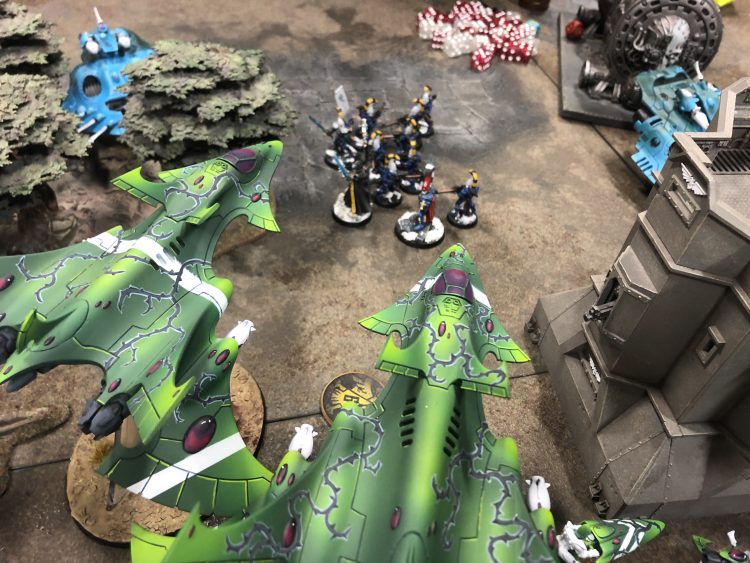
Secondary Objectives
- No massive standouts, but at least some opportunities for several.
Rounding out Eldar’s army rules, you get four Secondaries to play with as long as your army is pure Asuryani or Ynnari (or that plus a Traveling Players patrol). They’re an interesting mix of stuff, and none of them look like they’ll never work, but there’s a cynical degree to which what you’re hoping for from Secondaries as a player of the faction is two that suck and one or two that are auto-takes, and these seem to fall into all being middle of the road. They do at least all give you something very different you can do in each of the categories they cover.
Starting with Eldar sorcery, Scry Futures in Warpcraft rewards you for performing Psychic Actions on each objective on the table. It doesn’t line up well against Psychic Interrogation if you’re doing it with a Warlock or Farseer, but it’s unusual in allowing non-Characters to do it, so if you’re a fan of Wraithseers and Hemlocks (and yes, we checked, as far as we can see there’s no blanket prohibition on AIRCRAFT doing Psychic Actions, just normal ones) it can give you something pretty good to do with their casts. Scout the Enemy is hard to read as a Shadow Operations Secondary, but may actually prove decent in armies that can’t bring the stuff to cover RND. It lets you perform an Action anywhere outside 6” of your own deployment zone, which finishes at the start of your next turn (or the end of the turn if Rangers are doing it) and gives you either 2VP or 4VP depending on whether the unit is wholly within the opponent’s deployment zone. Probably hard to max, but there’s a degree to which being able to just slap a unit of Rangers in the corner and count up to 10VP in some matchups could make it somewhat useful.
Wrath of Khaine and The Hidden Path are both things I want to see more on the table to properly evaluate. Wrath is super swingy, essentially giving you 1VP if an Aspect Warrior unit kills something in the shooting or fight phases, and 4VP if you manage both with different units. That’s a strong rate in a category this army may sometimes struggle with, but leaves you open to some big blowouts if things go wrong and your Aspect Warriors get rolled up. Realistically, if you’re planning around this you should probably have at least one Phoenix Lord in your army, as they have the keyword and are pretty much guaranteed to still be operational in the mid-game. The Hidden Path is a complete departure from most Battlefield Supremacy choices, essentially creating a game of king of the hill on one objective that’s >6” from your deployment zone, giving you incrementing rewards for each Command Phase you hold it in. Alternatively, if your army has a Webway Gate in it (which it genuinely might!) that becomes the objective instead. It’s slightly harder to hold (you have to completely prevent the opponent being within 3” in your Command Phase) but has the payoff that you get to place it, and that being near a Webway Gate is going to be an extremely bad idea for the opponent a lot of the time.
Hard to say exactly how these are going to play – if Aspect Warriors manage to stay on the table then Wrath starts looking great, but that’s very much a question mark (though you can get a respectable score on it with just a couple of good turns, which may tip it over), and the rest need quite a bit of planning put into them. The Hidden Path may be the surprise standout here, since it’s likely that anyone playing against a Webway Gate will soon learn that within 3” of it is not where they want to be.
Boon: The secondaries I think are where this codex is going to struggle the most competitively. This is extra hard because I think secondaries are more important now than ever with the increased scoring on primary vs last year (all primaries are capable of netting 63 points vs 60 previously, one less Domination mission). The army just won’t have the throw-away action units many have for reliable secondaries like RND and doesn’t want to be over-extended for things like Engage. Psychic Interrogation is an extremely enticing secondary, but it also requires concessions in list construction or on table play that could be hamstringing the army. Without a strong reliable option out of the codex, I think the army will be forced to select against the opponent’s army which rarely leaves good options in competitive play.
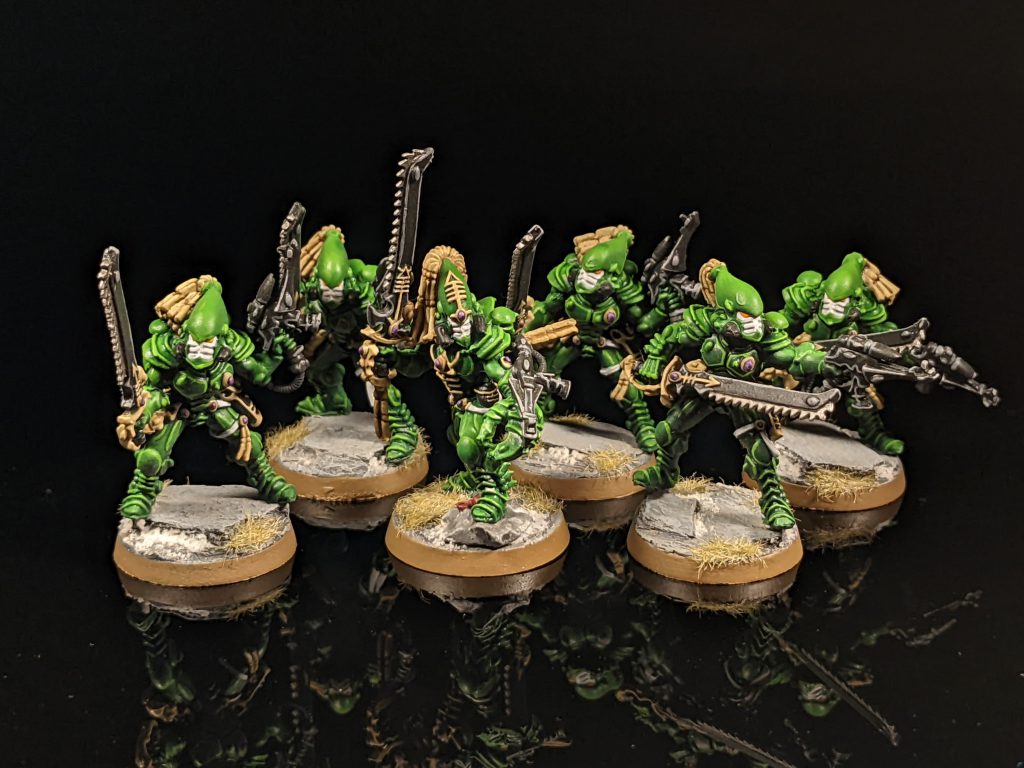
The Units
- General improvements to weapons across the board, notably including significant boosts to shuriken weapons, and d3+3 damage shots in quite a few places other than the expected bright lances.
- High price tags on a lot of stuff – you really pay for stuff in Craftworlds. A few things buck this trend, and are very valuable glue for the army.
- Generally underwhelming Troops slot and very strong Elites can make list building challenging.
- Notable improvements to melee aspects, with the all-important three attacks base.
- Fitting in dedicated RND units can be tough, making Will of Asuryan or Harlequin allies key.
Craftworlds have great units, but they’re expensive and awkward to get into lists. Most notably, the move of Dire Avengers from Troops to Elites is absolutely brutal to army construction – they’re now powerful enough that you’d be very happy filling a Battalion with them, and you want some in most builds, but making that work is now a challenge. This makes using a Harlequin Patrol as your Warlord detachment (plus to bring some good RND units) alongside an Asuryani Vanguard a genuine consideration, and other lists we’ve tried have ended up with pure Outriders.
Also, for anyone who read the Eldritch Omens review, it looks like some Aspect equipment got some nerfs after that went to print, with the most notable changes being that Banshee Masks only work when you charge (and don’t apply -1A), Dragon fusion guns are just d6+2 damage now and don’t boost to d6+4, and death spinners don’t auto-hit. Bear that in mind while looking at the relevant units.
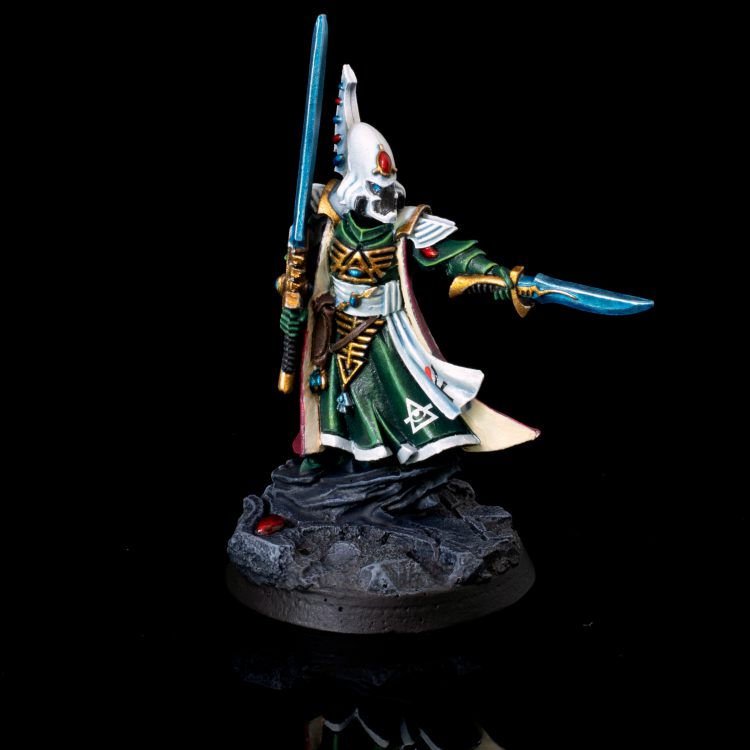
HQ
- Farseers and Bike Autarchs go in most lists.
- Phoenix Lords look like they have some play, especially melee ones.
- The Avatar struggles in Tau meta, but might have some play in a Webway Gate list, or if Tau take a hit.
The very clear default for an Asuryani list is going to be to start with a Farseer and Autarch Skyrunner – the former because you need the casts, the latter because putting Sunstorm on one makes them a tremendously powerful piece to play with, especially with re-roll force multiplication on top. Happily, both are also improved compared to 8th – the Farseer is quite a bit cheaper than they were at 120, while the Autarch gets a small discount, five attacks, and a small but important boost on the laser lance – it’s still S6 on the charge, but is now flat S+1 all the time as well, so considerably better when on the defensive because the change from S3 to S4 is massive. Foot Farseers also get quite a lot cheaper at 90pts a pop, and that probably means there are builds that want multiples. Eldrad is also still a reasonably expensive but extremely potent upgrade on the foot version; knowing three powers is very strong, since that allows you to tick off your core three on just him, and he’s also picked up Transhuman (Transaeldari?) Physiology and retains Psychic test re-rolls.
The other big splash in this section is from Phoenix Lords, because on top of Favoured of Khaine making them a pain to kill, each has an aura that gives their Aspect keyword Objective Secured – and they themselves have the keyword to benefit from it. ObSec on something that sometimes flatly can’t be killed at a crucial moment is obviously excellent, and makes the melee options here look particularly cool (though all have at least some appeal). In brief, Asurmen is deadly fighter who keeps a 3+ invulnerable save, meaning there’s a reasonable chance of him walking off opposing plans to two-phase him, Karandras is a nightmare killing machine who can start 9” away from the enemy (and, with Phantasm, be safely whipped back into the webway if you go second), Jain Zar brings a whole host of debuffs when she impacts, Baharroth has an extremely powerful bit of redeploy jank which is great on a fast ObSec model, Fuegan can drop a comedy damage four beam shot through the enemy’s lines, and Maugan Ra is a great durable holder for a home position. Lots of fun to be had, and expect to see most of them experimented with.
The other big (literally) splashy toy here is the Avatar, who certainly looks at least interesting thanks to the Webway gate existing. He’s expensive, but hugely resilient to big shots, and can be buffed to the gills with Farseer powers. Being able to place a Webway gate and then pull the Avatar with Phantasm when needed (i.e. against Tau) puts him in an interesting spot where it’s probably overpriced, but lists that can work with him might exist.
The rest of this section is fine, but not spectacular. Foot Autarchs have some cool builds, but aren’t any cheaper than bike ones if you take a mobility option, meaning Sunstorm probably leaves them in the dust. They also have the bizarre issue, as in Eldritch Omens, where the Autarch that’s on the cover of the codex isn’t a legal build. Yriel and Illic both still do some OK things, but Yriel is a foot Autarch with no mobility tools, and Illic is too highly priced to be a draw. Finally, if you just want the cheapest relevant HQ possible in some sort of skew build (or are going hard on Wraiths), Spiritseers exist.
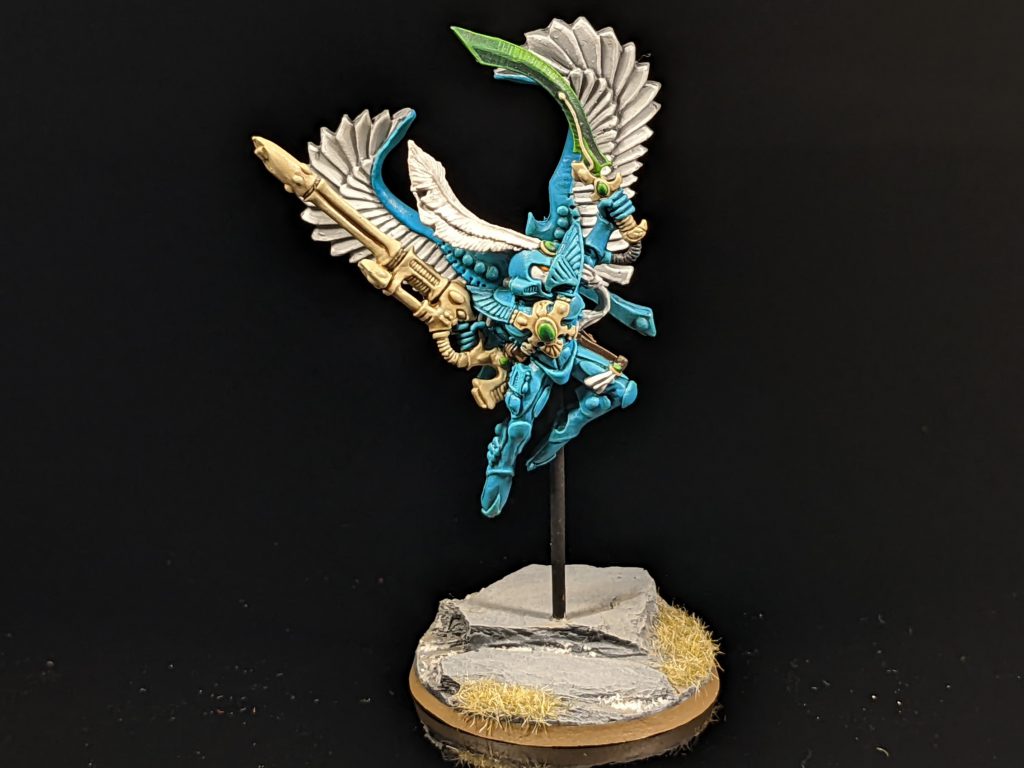
Boon: I think the biggest struggle in list building is going to fall into how to balance HQ selections with the rest of the list. Across the board the Eldar roster is high-priced, and the trade-off between pricey characters that are essential to get the most out of the roster, and the meat of the roster is going to be tricky.
A lot of this section is going to come down to how you plan your secondary choices for a given list – a single Farseer can be a struggle when you need both its powers to be successful but then also needs to be actioning for Psychic Interrogation. While it can still be done with a combination of stratagems (Unparalled Mastery/Multifaceted Mind) 2 CP in a turn is a steep cost in addition to everything else needed to ensure your success army-wide. That means you’re likely bringing a second utility caster, either a bike Warlock or a second Farseer, that can be both mobile and provide additional casting options. Afterwards, Autarch or Phoenix Lord starts to look expensive quickly. Alternatively, this is where a Shadowseer might step-in nicely with a Harlequin patrol, but that’s another topic altogether.

Troops
- Rangers are go-to cheap slot fillers.
- Both flavours of Guardians get better stats, but have high minimum squad counts at 10 and aren’t cheap.
- Corsair Voidreavers provide the cheapest source of ObSec troops, but don’t fill detachment slots.
Making good Battalions has always been a challenge for the Asuryani, and this book is no different. Guardians and Storm Guardians both go up to 4+ saves, get AP on their weapons, and conditional re-roll 1s to hit (Defenders if they’re holding an objective, Storm Guardians if their target is), and that’s all neat, but a starting price tag of 90pts for ten Defenders, going up by at least 20 if you bring a platform, makes them pretty pricey for what you’re likely to get out of them. Storm Guardians are slightly cheaper, and bringing their fancy new Serpentscale Shield gives them some good anti-shooting defences, but that’s also 20pts meaning a squad jumps to 100. It feels like filling out armies with these is going to need you to take a Webway Gate, and at least there being able to reliably dump ten Storm Guardians onto an objective on turns two and three might be worthwhile, but it feels like in both cases the platforms could maybe have borne starting at a lower price.
That leaves Rangers, now forward deploying and with some anti-charge tech in the Wireweave Net, as your cheap Troops option. That’s fine, especially with Phantasm to redeploy as needed. You probably want access to a couple of units of these as a Craftworld player, and 3×5 lists probably do happen.
Also in Troops, and now available for Drukhari as well, are Corsair Voidreavers. Sadly, these have a special rule that they do not fill mandatory slots in detachments (unless you’re building a pure AHNRATHE detachment, which means taking Yriel, which means you’re either doing this as a weird little bolt-on in a soup list or playing Iyanden). Even without that, you get a basic unit (all sporting power swords and auto-wounds on 6s to hit, so not even un-scary) for 50pts, so if you’ve gone for a list using a Vanguard or Outrider and want some ObSec support or a RND unit they may have a role.
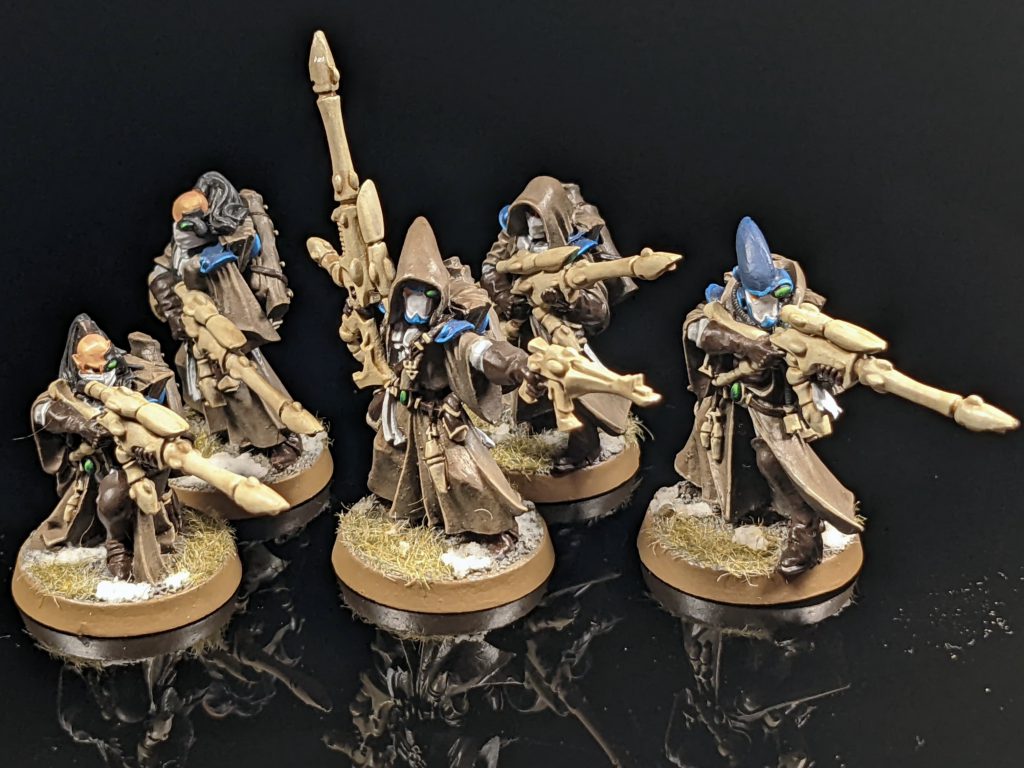
Boon: It’s been a while since we’ve referred to the “troop tax” with Craftworlds but I think this is what we’re back to unfortunately. This army will want to leverage as much CP as possible, which incentives a battalion selection to get the most out of the Elites, Fast Attack, and Heavy Support slots – but in doing so it’s forced to consider some of the worst options available to it. Guardian Defenders can put out a high volume of fire, and with the proper synergies, can result in some significant damage output – but it will require building around and it doesn’t come cheap. Corsairs cannot fill compulsory slots, and the cheapest option are Rangers coming in at 65 points base – unfortunately they’re not particularly durable and don’t have the offensive output that I would think justifies that price tag. You’re forced to pay it but you’re simply trying to make the most of it – a tax. They do have some interesting utility with Fate dice and a wound, but that’ll be situational at best.
The one thing I really like in here is the Rangers keyword Resonator Shard which opens up an interesting design mechanic by allowing Craftworld indirect hit rolls (Nightspinners, D-Cannons, and Shadow Weavers) to be rerolled with the Resonator Shard stratagem if the Rangers unit is within 12” of the target. My personal favorite option to address the increasing oppressiveness of indirect shooting is to restrict rerolls on any shots that are coming from out of direct sight – only giving exceptions for things like ‘spotters’ or specific abilities such as the one provided by the Rangers here. It’s a potentially neat, tidy fix to a problem that has a lot of strong opinions.
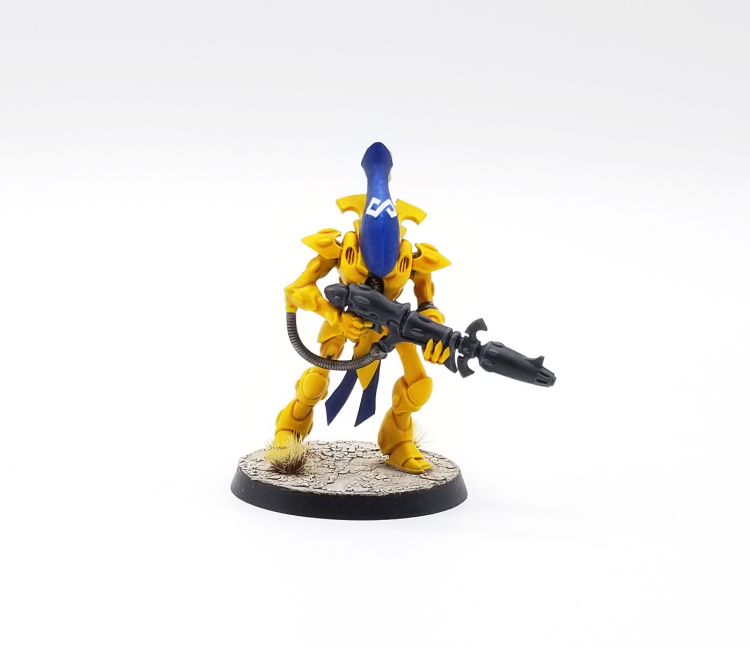
Elites
- Wildly overstuffed with goodies, which makes the difficulty of building a Battalion sting.
- Dire Avengers have brutal shooting output, and can Action while shooting, helping with Objectives.
- Banshees and Scorpions both get a wildly powerful first unit thanks to their best Exarch powers.
- Warlocks can now either be taken as single-model Characters or multi-model units, with varying prices.
- Wraiths are mostly terrifying but expensive, though Wraithlords may have some pretty efficient builds.
- Fire Dragons are utterly brutal when they work, but questionable in the current metagame.
- Corsair Voidscarred give access to the stranger weirdos from the new kit, and probably end up most interesting for Drukhari.
There’s so much good stuff here that it’s challenging to know where to start. At a baseline, assume that the first unit each of Banshees, Scorpions and Dire Avengers with their best Exarch Powers are building blocks for a bunch of lists, providing a great counterattack unit, potential early bullying and a flexible, cost-efficient Action unit respectively. More of any of these still seems plausible as well, and taking ten Dire Avengers in a Serpent planning to set up double shoots seems realistic as well. Fire Dragons are very much an all-in unit, but with the right metagame shifts could be potent as a unit of six podded in via a Falcon, especially if you’re able to get Will of Asuryan on them or perhaps play a custom Craftworld to let them RND something and still shoot. At the moment, however, the number of good invulnerable saves and anti-re-roll tricks is way too high for them to reliably do what you need, though they are marginally more likely to get a second go than they used to be – most Aspects are a little tougher to clear than before, as they all now get 5+ invulnerable saves, and Dragons get a nice little extra bonus in the form of T4. Similarly to Eradicators, it feels like the potential for Dragons is very scary and there absolutely will be times that they drop in and annihilate a key unit, but there’s also plenty of occasions when playing into top-class competition that they’ll be forced to coin-flip into something with an invulnerable save, achieve nothing, and then immediately die.
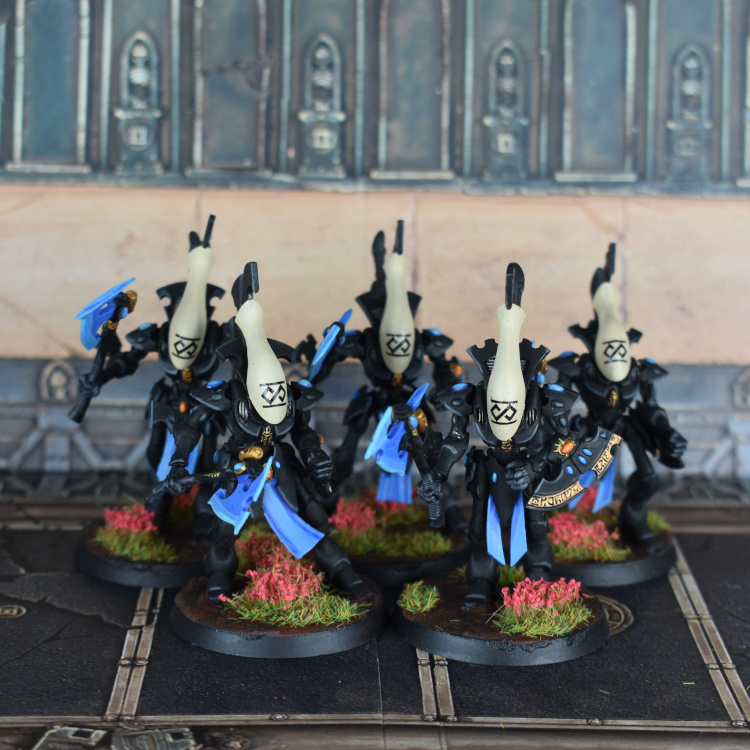
Speaking of the Elites slot being overstuffed, all non-Titanic Wraith stuff is now here, including Wraithlords, and it all has -1D. This is obviously great, but you pay for it on the medium-sized Wraiths at 40-45 points each depending on loadout. At that price, Wraithblades still look pretty anemic for their cost, but a giant brick with axes and shields with ObSec from Will of Asuryan is likely still something that will be worth a try. Wraithguard get the fairly exciting spice of their wraithcannons getting boosted range and d3+3 damage, so potentially interesting in a Webway Gate list. That’s especially true because they can shoot while in Engagement Range, so even if the opponent body blocks part of the space gate with a tank, they’re in for an extremely nasty surprise when you deploy into combat and mess them up. Ulthwe feels like the best home for these, as adding a 6+ invulnerable save to use with Strands helps a lot. That’s also true for Wraithlords, who get very nasty now when given the glaive, which provides both S9 attacks for d3+3 damage and a D2 sweep attack, very versatile. A Wraithlord with two bright lances and the glaive rocks in at 155pts, and that’s maybe fine on rate? Cheap ones with just the glaive are also good for filling space durably and providing countercharge threat.
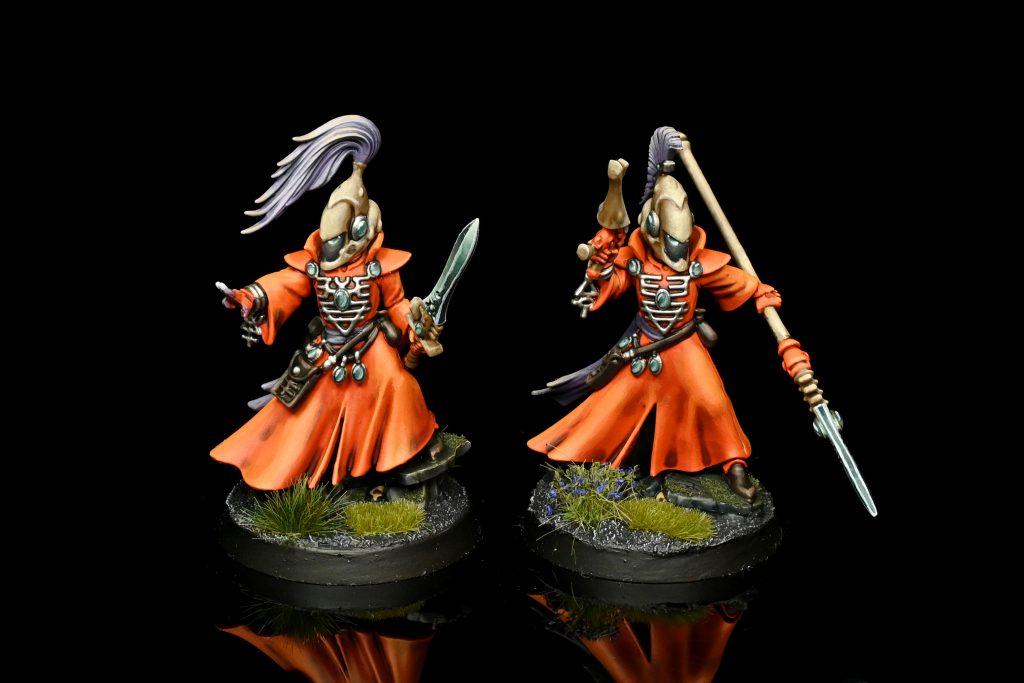
Warlocks are still Warlocks, though the two versions of each datasheet have now been merged. When buying these, you can choose to either take a single-model Character unit at 40pts, or 20ppm for a multi-model non-character unit that gets an extra known power and cast if large enough). Mercifully, you also get to take one slotless Warlock unit per Farseer unit in your army, helping to ease the pressure on listbuilding a bit. Given the current metagame skew, and the utility of being able to do Psychic Secondaries in the Nachmund book, single Skyrunners are likely going to be the most common, but the price tag per model on foot Warlock squads is actually extremely aggressive, so we’re not completely ruling out someone finding a way to use them. Four at 80pts for two casts and something that can sit at home really isn’t that many points.
Finally, more Corsair weirdos, this time the weird weirdos. The main thing that differentiates the Voidscarred is being able to add a Way Seeker for 25pts, who is a Runes of Fate or Fortune caster, and if the number of smart missiles in the metagame goes down it seems at least somewhat plausible that Drukhari might want a six-model 85pt unit who can farm them a CP every turn with Fateful Divergence. Probably not much play for Craftworlds though.
Boon: Talk about going from zero to hero. The elites force organization slot is probably the hardest to make trade-off decisions around if you aren’t building out a battalion – nearly every unit in the previous edition got significant buffs that make them viable selections and on top of that new options were added to the category in Dire Avengers, Warlocks, Wraithlords, and then the Corsairs.
How you choose your units is going to largely depend on how you’re building out your list – Wraiths are likely to see very limited use unless going all in on a wraith build. As noted, both Striking Scorpions and Howling Banshees have some deadly options available to them in Crushing Blow and Piercing Strikes respectively, as well as some utility tools in the Cronescream relic. I personally favor the utility of the Howling Banshees – ignoring OW, forcing a fight last, and being +1 to wound on the charge gives them a wider range of targets to threaten – however, they will both hit like a ton of bricks, especially when boosted by Fate or Battle powers.
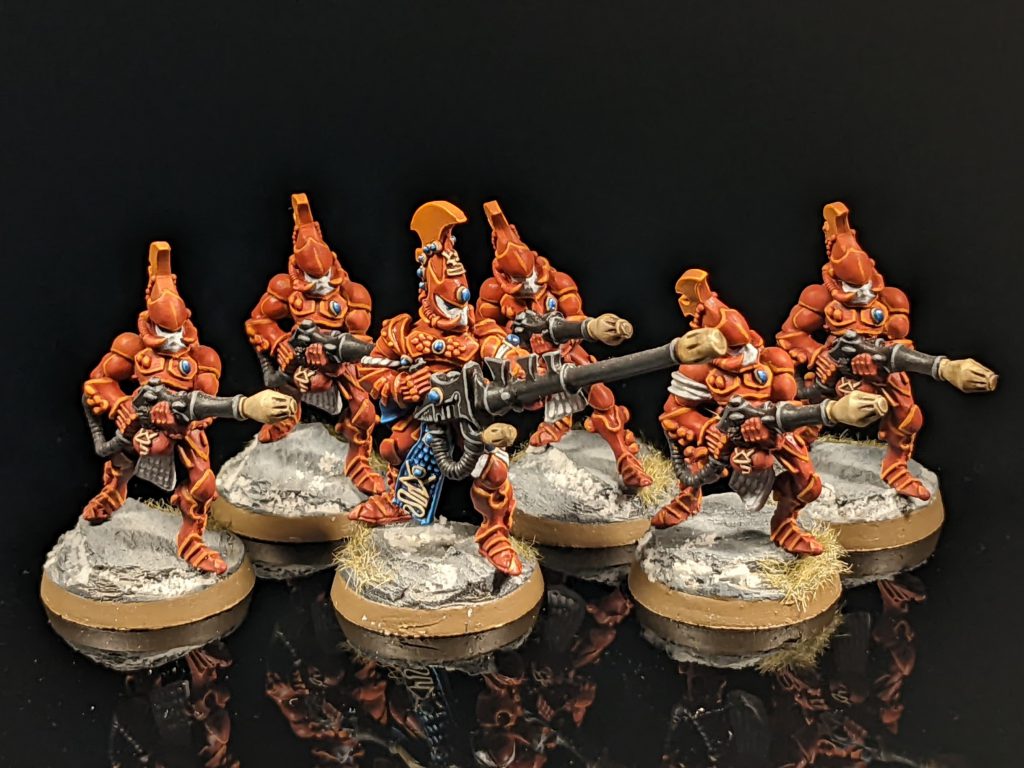
I’m still not sold on Fire Dragons. I love that unit and they got some badly needed boosts in their damage output and interactions with other units (Falcons, Webway Gate), but they’re still handicapped by a high potential to do nothing. Many of their primary targets in the meta carry a decent invulnerable save and their true enemy, variance, is real. An opponent spiking on 4+ invulnerable saves then immediately wiping your Fire Dragons that had been its main threat will never feel good, and in the typical six GT tournament will happen more likely than not. Perhaps most limiting is their Exarch abilities, which are good but expensive, and aren’t particularly impactful coming out of reserves or a Falcon.
We shouldn’t neglect that Shadow Spectres also reside in this role, still have significant ranged capability, and are also the most likely unit to benefit from Battle Focus changes, particularly in a Biel-Tan list. It remains to be seen how or if any changes or updates are made to them following release.
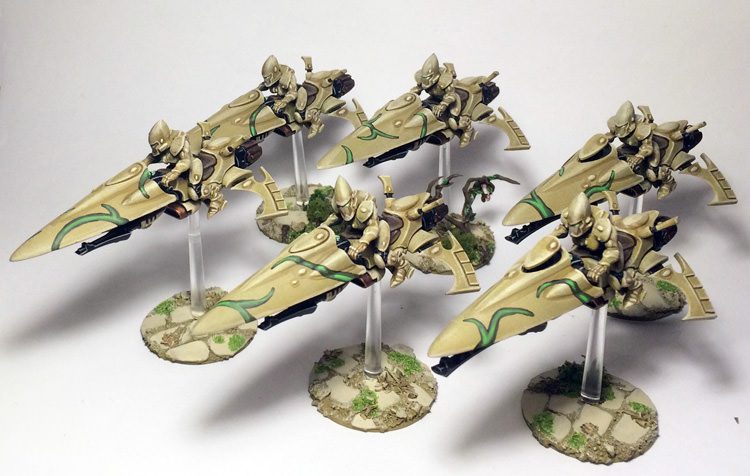
Fast Attack
- Windriders and Vypers are some of the book’s most cost-efficient units.
- Spiders and Hawks have some good tricks, but are very expensive for T3 models.
- Shining Spears are still very high threat with lots of buffs dumped on them, and small units are scarier and stickier.
- Shroud Runners feel too expensive to really land.
Eldar are notoriously fast, and this slot has some real goodies in it. Shuriken catapult Windriders are a very pushed unit, coming in at twenty points per model, going up to a base 3+ save, and re-rolling hits of 1 when shooting targets on an objective. Dropping Will of Asuryan on six of these and ticking off a RND quarter while also blasting something seems seriously legit. Vypers also seem strong because they’re very cheap – 40pts base, and you can bump one up to lugging a bright lance around for only 55pts. Great as an inexpensive thing to park on a home objective, ready to screen characters, tick off quarters for Engage, and occasionally use an auto-hit and wound from Strands to zap something in an emergency.
Spiders and Hawks are speedy utility aspects, and both have some steep price tags but potent tricks to go with. Although more expensive, Spiders seem more plausible here – their guns are pretty scary (d6 shots Blast at S6 AP-2), and adding Surprise Assault to the Exarch pushes their impact the turn they arrive high enough that you might get good value from them. They also have tremendous movement tricks once they’re operating on the table – they get to Battle Focus 2d6” rather than d6”, and the first time they’re charged each turn they get to make a Normal Move of 6” to zip away. Hawks get to flat out redeploy instead of Battle Focusing, but the timing on that means it’s not usable for any sort of Action tricks, and they lack the serious killing power of the Spiders (though they’re much deadlier than they used to be).
Shining Spears were probably the most enduring standout unit in the 8th Edition Craftworld book, and still look good here as deadly counterattack threats. In line with other Aspect Warriors they now have a 5+ base invulnerable save, which is a distinct sidegrade for them compared to their old 4+ against shooting – they’re a bit easier to clear out in the open, but stickier in melee, which was a problem for them before. You can also buy the Exarch an upgrade to a 4+ invulnerable save for a mere 5pts via the Shimmershield (which you should) and the new kit gives them access to a free shuriken cannon, which is pretty cool (and probably worth taking, as you’re usually aiming to charge with these). Like other melee Aspects they go to 3A base (4 for the Exarch), which means running small units with the Shimmershield and cannon upgrade for 110pts seems extremely realistic. Biel Tan may also get value out of a big squad with extra upgrades, as with Guide and Wrath of the Shrines up it seems pretty plausible they can smoke a good unit in two phases the turn they commit, but that is a heavy investment (and how practical doing this with large flying bases is remains to be seen).
Finally, Shroud Runners are weird – it feels like they maybe got a last minute point bump they didn’t need (their PL has gone up from 4 to 5 compared to the Eldritch Omens datasheet). They’re very fast, throw down a good number of scatter shots, and have a decent stratagem for meddling with the opponent up close, but they don’t quite feel like they’re filling a role the army actually needs at 105pts minimum. Could be wildly off base on this, and someone could find a neat build with them, but right now they seem an awkward fit.
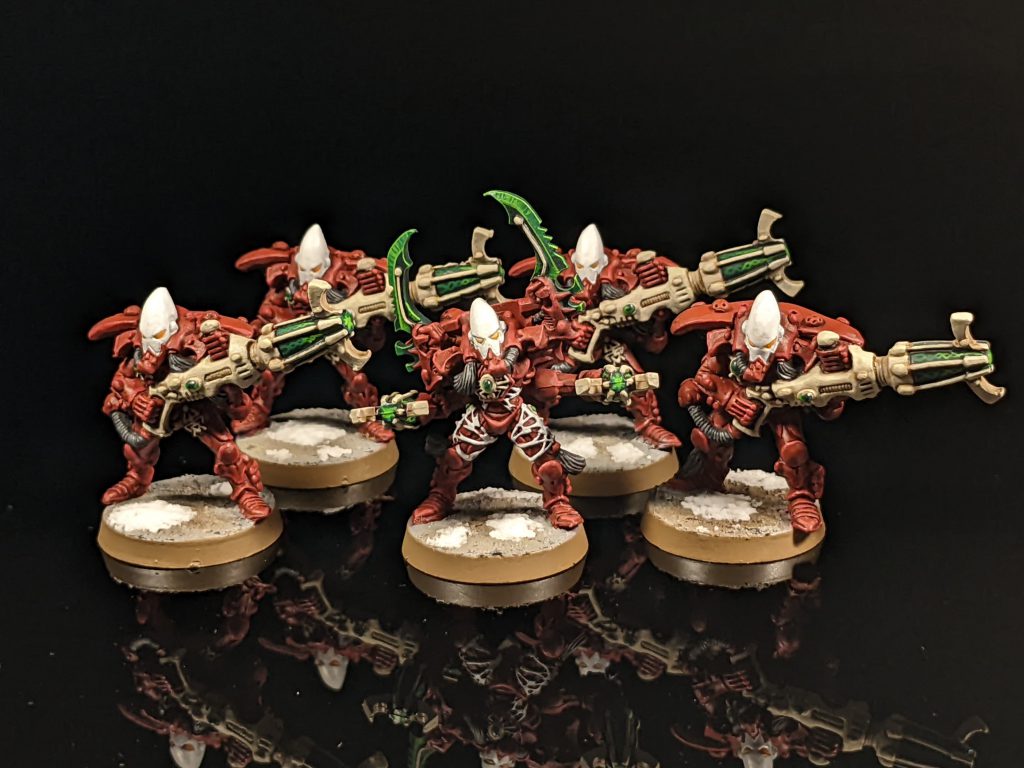
Boon: To add to the weirdness of the Shroud Runners, they are clearly intended as Ranger/Outcast units but also lack one of the more interesting aspects of the Ranger units – the Resonator Shard keyword that facilitates a support role for non-LoS platforms. I really struggle to identify what role this unit is intended to play in what is actually a very competitive Fast Attack force organization slot.
The Vypers and Warp Spiders are my personal favorites in this category. Previously the Warp Spiders package was offensively limited with an output of 2x Strength 6 AP 0 shooting per Deathspinner (which went to AP-4 on a wound roll of 6) but offered access to an incredibly fast and flexible unit which had been the premier Retrieve Octarius Data unit when combined with the Exarch’s Web of Deceit ability. The most recent incarnation of Warp Spiders tamps down some of that flexibility due to a combination of factors:
- Much more restrictive movement with the changes to their Warp Jump Generator
- Changes to the mission secondaries in the most recent GT mission pack limit actions or introduce increased risk
- Changes to the Web of Deceipt ability (action timing) and the limitation of Battle Focus (requiring you to have shot)
The unit also comes in at 100 points base vs their previous 90 points – before any Exarch upgrade abilities (Surprise Assault being the likely front-runner). However, the role that the unit takes on has shifted significantly but not necessarily for the worse. First and foremost, the offensive output of the unit is much improved, and importantly, provide one of the best options in the Aeldari book for ranged anti-horde while still seriously threatenening most mid-sized vehicles and elite infantry. While not as fast as their previous version, they still retain a very significant capability to befuddle your opponent’s plans when combining their Warp Jump Generator, Battle Focus, and their charge response abilities. Finally, this is a unit that wants to have Will of Asuryan cast on it – allowing it to leverage their huge potential on offense while scoring (particularly useful on Investigate Signals) and synergizing with other powers like Doom or Guide, stratagems like Wrath of the Shrines, or custom army traits like Webway Warriors. To me the current version of Warp Spiders is much less of a sneaky action unit and much more of a problem-solving utility unit that can fit nicely into multiple different roles within a list or within the game itself. The flexibility of this unit is still there but it has evolved.
The Vypers I think are one of the few units in the entire book that you could call cost efficient for their role – ther mobility combined with strong weapon options gives you a fast objective sitter and character screen that can punch well above its weight. As mentioned, the Vyper is an ideal unit to one-shot with Fate dice a key unit with d3+3 damage because of its combined speed and range. Like the Warp Spiders, the unit provides a fair bit of utility and is also just a refreshing take on what has long been an underserved datasheet – I like one or two of them in units of one if you have the Fast Attack slots for it.
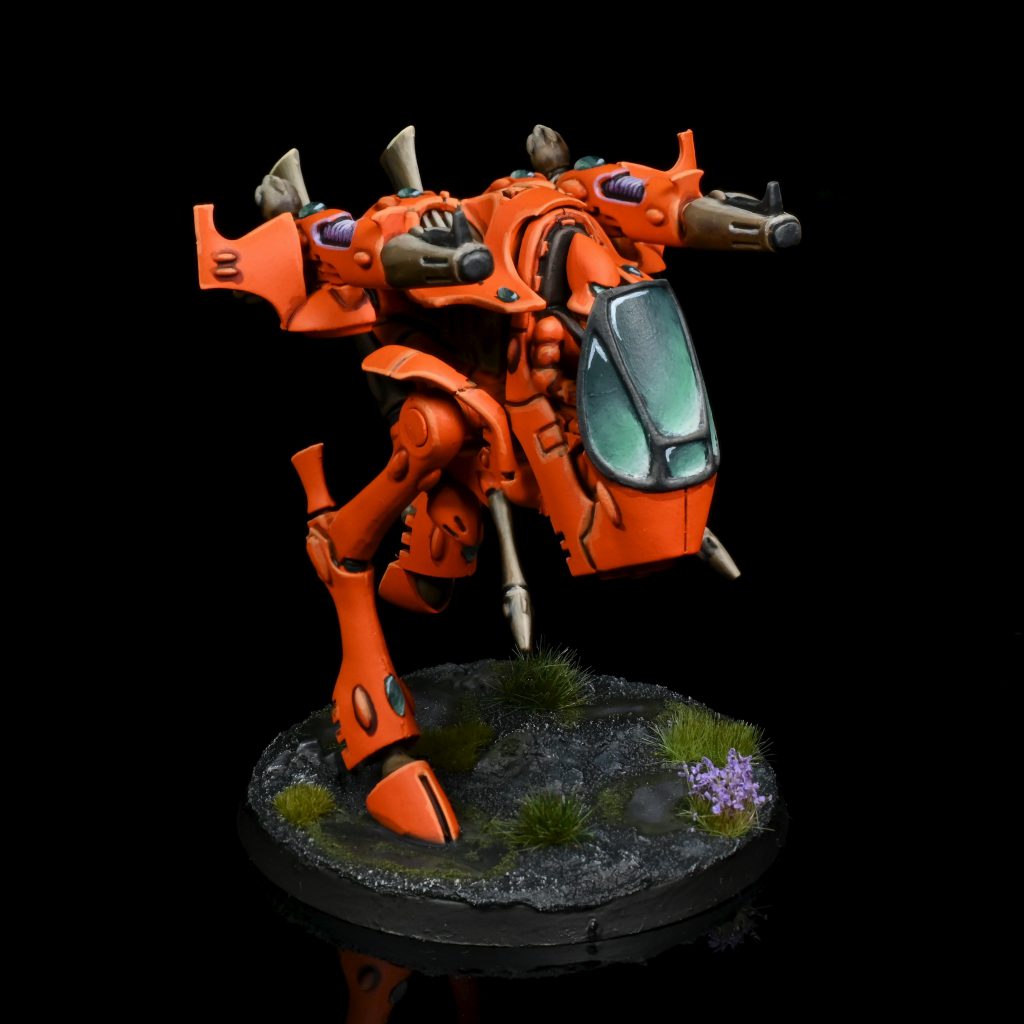
Heavy Support
- Drop Pod Falcons!
- Fire Prisms are still very scary to the right targets, and easier to run in twos rather than threes.
- Night Spinners and Support Weapons both have strong datasheets.
- Dark Reapers pay badly for the sins of 8th Edition.
- War Walkers are basically OK.
Drop. Pod. Falcons. That’s the big news here – the Falcon Grav Tank is no longer an anonymous middle of the road tank that’s sometimes good when it’s undercosted. Oh no. Now it’s a drop pod, with all that entails – it can deep strike turn one, and disembark what’s inside it when it does. Given that one with its pulse laser (a cool two shots at S9 AP-3 Dd3+3) and two shuriken cannons only runs 150pts, that seems extremely good, and if Fire Dragons or Reapers get there, this is probably how. Just bringing in six Dire Avengers to RND while shooting is really potent too. You, a fool: “Games Workshop makes new kits overpowered just to sell them.” Me, an intellectual: “This new Codex unleashes the true power of 1997 design classics the Falcon Grav Tank and the Vyper” (and, as an incidental point, Blood of the Phoenix looks like a hell of a box a mere 18 months later – if only we’d known).
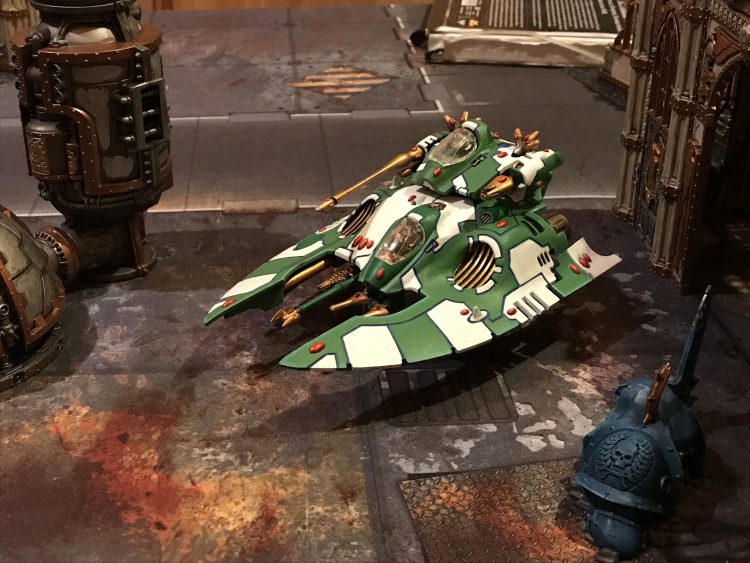
A lot of stuff in this slot essentially works as expected. Night Spinners get a juicy built-in AP-2 compared to their old varying statline, which is great, and Support Weapons get cheaper, making both guns that ignore LoS look tasty. The d-cannon in particular is extremely scary, going up to a terrifying d6+2 damage statline, and while a squad of three does run you 195pts, that will absolutely dominate the mid-board if your opponent doesn’t have a good way of reaching out and dealing with them. Each also has a weirdly high number of melee attacks, so a small unit bully charging them can’t absolutely guarantee that they’ll get away with it – definitely interesting overall. Worth mentioning too that they have the GUARDIANS keyword, so can be handed re-roll 1s to hit with Martial Citizenry in any Craftworld, or +1 to hit in Ulthwe.
Wings: I’ve come back to add this after our first pass, because honestly, the more I look at D-cannons the more I wonder if they might just be one of the best things in the whole book. The threat they represent is wild, and having them be able to be taken in units proper now is good, as it provides good stratagem synergy with various sources of re-rolls, the ability to move a bit to get range then pull back with Fire and Fade or pull the unit out of combat safely with Feigned Retreat, and makes them really strong To the Last choices, especially as now they don’t split the opponent has to kill the whole squad to stop you scoring. The range isn’t huge, but in terms of sheer killing power they’re vastly outside the range of what you can normally do with artillery, and they’re also great into the current metagame. They’re d3 shot Blast, so carefully timing the volley so it lands on a Crisis team with five models and one drone left can result in catastrophic damage, and the fact that they’ll smoke Custodes models without breaking a sweat means having a unit waiting to shoot makes the decision of when to pop Arcane Genetic Alchemy and Emperor’s Auspice, and worst case you can just split fire. I hope I do not need to explain why they are also, in fact, good against Crusher, and you can even pull them to Strategic Reserves going second if you lose the roll off against Hive Guard. I can absolutely believe that a skew build emerging from this book is just to take 3×3 of these as your To The Last every game and dare the opponent to try and cross the table to get to them.
Also in the “interesting” bucket are Fire Prisms, whose main gun gets scarier than ever, and can bypass invulnerable saves with Linked Fire as long as you bring two. These seem maybe OK in Biel Tan, because the hit re-roll is very good on them, and if you’re planning on linking fire you can also buy one Vectored Engines and a Crystal Targeting Matrix for a once-per-game Battle Focus and to ignore any hit penalties respectively, letting you land a solid blow and then re-hide the firing model at least the first time. Finally in the “as expected” category, War Walkers are still decent gun platforms, and now scout deploy, which is cute. They may struggle to compete with Vypers for filling armies, as they’re maybe a bit over-pointed, but certainly aren’t bad either.
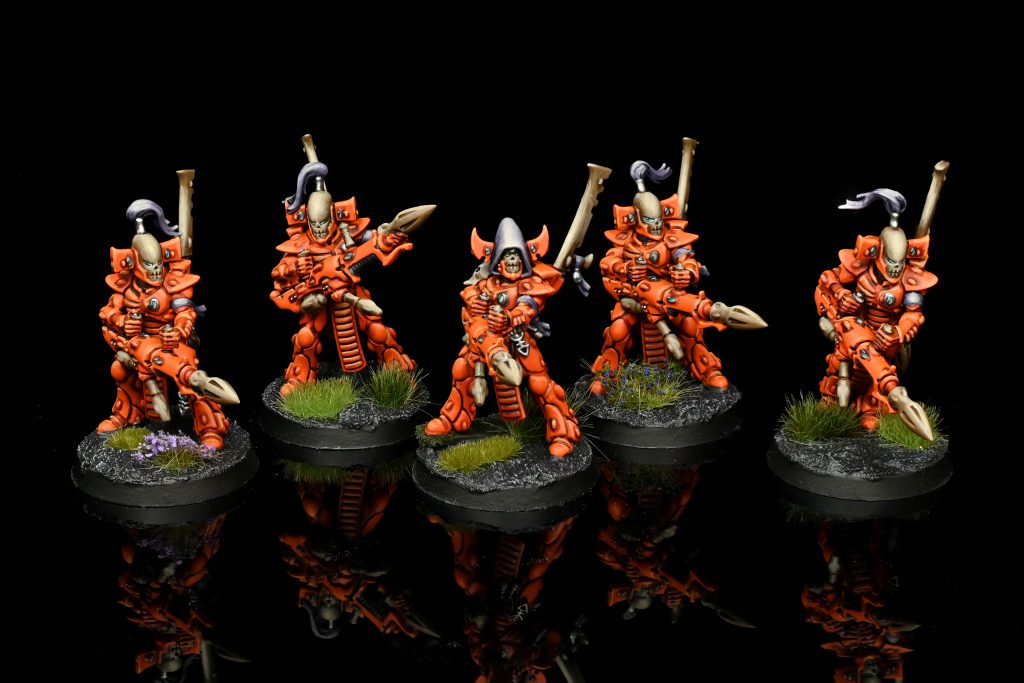
Sadly, our final entry here is a bit of a blow – Dark Reapers appear to be firmly on the naughty step this Edition, locked to a unit size of five, losing the ability to always ignore any penalties (just dense), and no longer able to Fire and Fade into a Transport, leaving them hugely vulnerable to indirect fire. No-one who had to play against Ynnari Reapers is likely to mourn them too much, but it’s a shame for them to get a new plastic kit and be consigned to the cabinet in the same release. There’s maybe still a place for a single unit podding in with a Falcon and using the Reaper’s Reach Exarch power to ignore the penalty for doing so, but in general this unit takes a significant knock; like a few other 8th edition standouts, it seems like the balance goal for these was to turn all the knobs at once and assume somewhere in there a problem last seen in around mid 2019 would be fixed.
Boon: I’ve been back and forth on this slot – there’s good options here and each of the Falcon, Fire Prisms (probably two if you take them), and Nightspinners have a strong argument for inclusion – but they are all expensive and can be difficult to hide from alpha strikes. Increasingly I find myself gravitating to simply a bevy of support weapons. Both Shadow Weavers and D-Cannons have nice utility combined with the Biel-Tan trait or the Resonator Shard stratagem. The former is effective at picking off backfield objective holders, while the latter mid-field threats and both are easier to hide and have a smaller footprint overall which limits some of the challenges faced by the larger hulls. The fact that none of the Farseer boosts (Doom, Fortune, Guide) or command phase buffs synergize with any of the heavy support slots (except Reapers) is crippling for such high priced units.
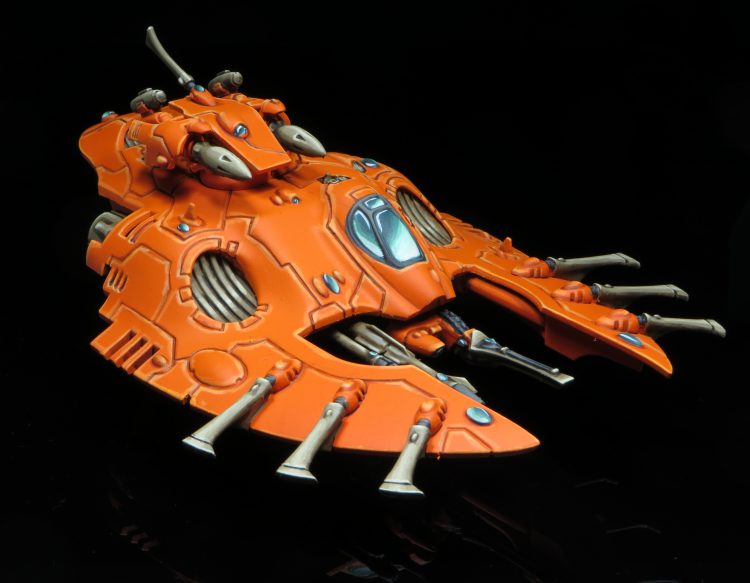
Dedicated Transport
Wave Serpents are still good, and you still need some to keep your units alive if they’re not jumping out of either the Webway or a Falcon. The Serpent Shield has been changed up, no longer providing damage reduction and instead enabling perma-Transhuman and a 5+ invulnerable save against shooting, and while it’s morbidly hilarious that Serpents have lost damage reduction given how much it’s been handed out recently, the new version is way better in the metagame – Serpents conventionally died to melta and dark lances, and this does way more against those. At 160pts for one with a twin lance, the price tag is also appealing. Good stuff.
Boon: It’s very good. Probably the biggest struggle Craftworlds will have in this extremely deadly meta is simply staying on the board – the Wave Serpent provides a huge boost there in terms of durability. The question a lot of players will need to ask themselves is how much they are willing to pay for this durability and what tradeoffs will they make. It’s not an easy answer given the relatively low output for the price.
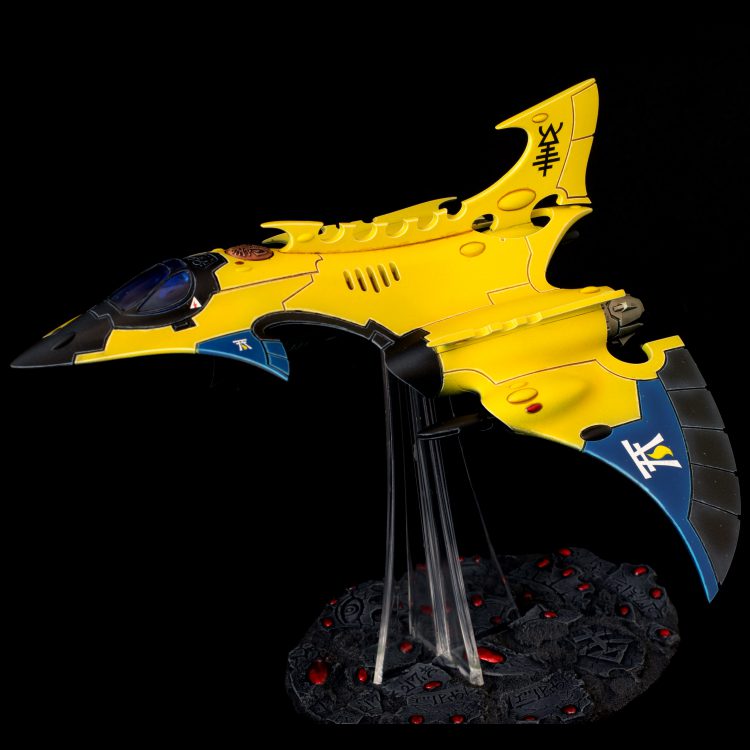
Flyer
- Crimson Hunter stocks down.
- Hemlock stocks up (maybe?).
- No more double turns – boooooo.
Good news for all non-Aeldari players – it seems very unlikely that Craftworld planes are going to ruin everything this time around. Crimson Hunters can pack on four huge shots, which is cool, but they’re 190pts base if you do that, and no longer get Wings of Khaine double turns, which hurts their durability even more as they can’t so easily stay at a distance. You could run one with the Swooping Evasion upgrade for an invulnerable save and BS2+, but 215pts is a lot (though maybe starcannons at 195 are a bit more palatable, especially as these have been bumped to S7). Like a lot of things in this book, the fact that you can pull them into Phantasm if you go second in a matchup that can one-shot them definitely increases the utility.
The Hemlock comes out rather better because it’s a Wraith and therefore gets the huge durability boost of damage reduction, while getting cheaper to boot and seeing a sidegrade on its guns (more shots and mortals on 6s to wound, but not auto-hitting). Being able to perform the Scry Futures secondary maybe helps a bit, as not being a total dead weight for scoring does help make a case for a plane, but the suspicion is that the price is still just too high here.
Boon: I’m frankly kind of shocked the double-turn has been removed from these planes. They’re paying for the sins of Ad Mech and their own past, but at these prices I think their inability to maintain a stable, ranged position is too detrimental and other options in the roster can provide similar capability with a little more defensive upside.
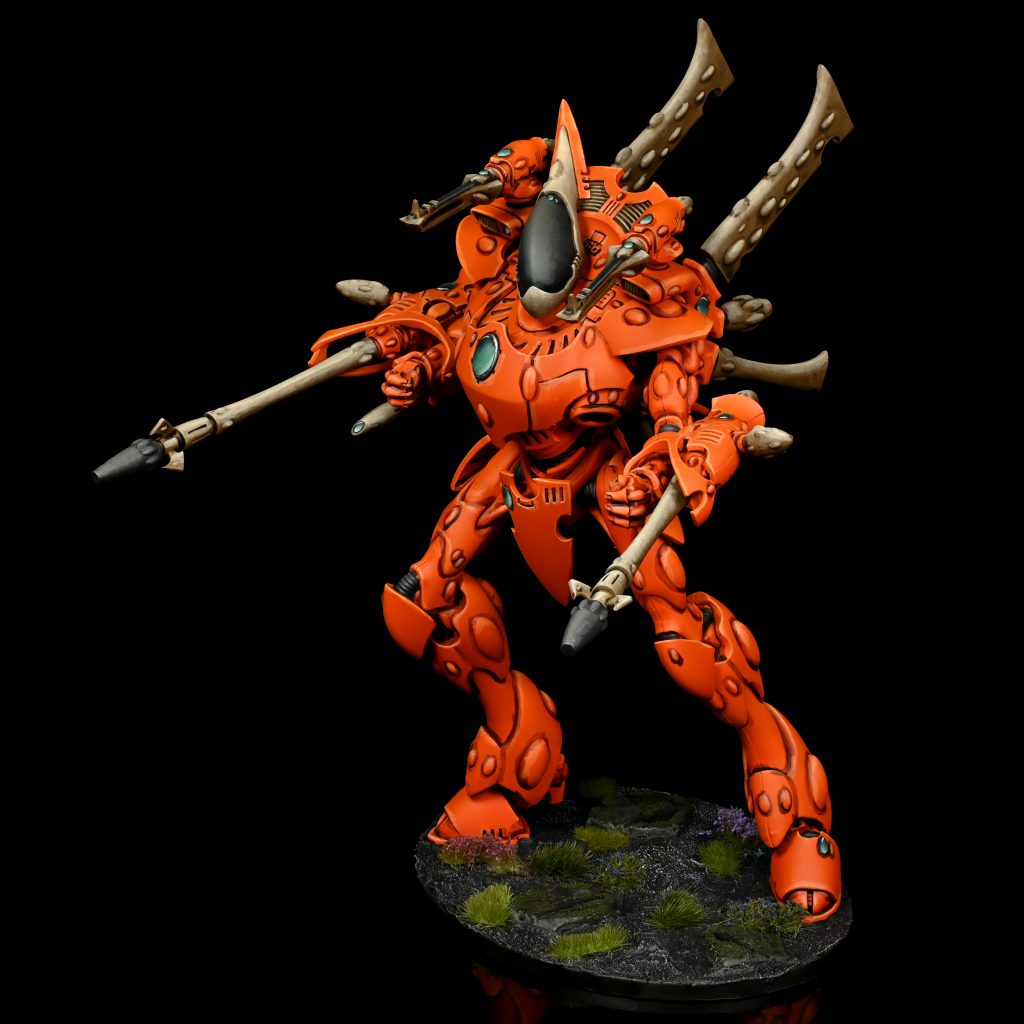
Lord of War
The Wraithknight is back, and has received some big buffs, but is still challenging to use. Obviously I am going to take one to an event at some point, it would be rude not to, but even with their newly chunky defensive profile, spending 400pts minimum on one (more with guns) is a tough sell, especially as titanic feet no longer give multiplied attacks (though the sword gets a sweep to compensate).
The good news here is that almost everything else about the datasheet is improved – base 5+ invulnerable save and damage reduction mean that you will get some games where you can just bully the opponent into submission, but the more subtle improvement, visible to me as the world’s number one Wraithknight expert, is that you have far more flexibility on loadout than before. You can now freely use any combination of the arms that come in the kit, meaning that in addition to the three available options in 8th, you now get sword/wraithcannon, wraithcannon/suncannon and wraithcannon/shield to pick from. This is huge, and my gut feel is that if any build is viable, it’s wraithcannon/sword plus two shoulder shuriken cannons at 450pts. That’s probably a little too high, but it’s a truly unholy killing machine with that setup, as the guns are way scarier now. Ask me again in like a month after I’ve made some very bad decisions at majors.
Boon: I’m not high on big bad models that pack a lot of capability into a limited frame – in my experience they’re too easily marginalized which can be devastating when you account for their price tag. Unfortunately, the Wraithknight falls into this bucket for me as it’ll be defined more by the current meta than its own individual capability. It benefits greatly from Fate dice saves, Fortune, and a Webway Gate entrance – but Longstrike and Tau generally immediately comes to mind as a reason not to run him over a six-round GT.
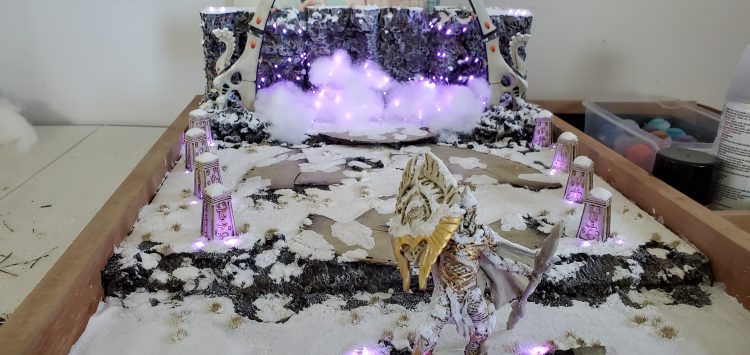
Fortifications
Games Workshop have been trying to make a Fortification really matter for ages, and they’ve finally succeeded – the Webway Gate looks genuinely incredible, and is potentially faction-defining. The rules for it were essentially entirely previewed on WarCom, and at the 80pts price tag it costs you it’s spectacular.
The Gate creates a little bubble around it where strategic reserves can arrive as if they were coming in off your board edge – within 9” of the enemy, even directly into combat and counting as charging, if needed. It also massively discounts putting stuff into Strategic Reserves to use with it – you get to halve your CP spend, rounding down, so anything up to 9PL of units is totally free, and you can do 29PL for 1CP. Don’t forget, too, that Phantasm now lets you pull stuff into Strategic Reserves – so if you have a gate, you can be hyper aggressive with Scorpions or Karandras (or both!) then just pull them into the gate if you go second, saving their fragile bacon and making it much easier to get them into the fight later in the game.
The portal is also pretty easy to deploy, given you can bundle the two halves very closely together (and should, it only helps you), and creates a massive zone of enemy deterrence once in play. The Webway Gate kicks ass, if you’re a Craftworld player you now definitely want to own one, and it’s spicy for Drukhari too.
Boon: Low-key the biggest winner out of the Webway is likely going to be the Drukhari who can now offset some of their increased transport costs or provide their Grotesques increased capability to threaten on turn two. That said, I can’t think of a Craftworld army build that wouldn’t be improved by one of these – providing significant alpha-strike capability as well as the potential to dominate an objective or two in a mission set that now predominantly sees 5-objective missions. Moreover, you’re not actually required to emerge from the Gate if it doesn’t suit you – you’re paying for the additional flexibility but may instead choose to enter the board along the more traditional Strategic Reserves route (board edges). In sticking with the theme of things I love in my lists, it’s a utility selection with great value.

How They’ll Play
Craftworlds are all about hitting hard and fast – their units are spectacularly deadly, but they’re fragile and pricey, so every blow you land needs to count. More than that, to really make sure you’re scoring effectively your units will often need to be pulling double duty – completing Actions using Will of Asuryan while blasting away at the opposition will be a big deal. Every Aspect Warrior unit in your list represents the potential to deal game-changing amounts of damage, but navigating them to a position where they can pull that off without being blasted off the table is going to take skill and practice. Helping you with that are tools such as Falcons and the Webway Gate, letting you mess with the normal expectations of how the game flows (as any good Aeldari should), plus the raw power of Strands of Fate, allowing you to bend probability to your will at a crucial moment. You also have a very few units that are surprisingly sticky – Phoenix Lords can stay in the fight like champions, and Wraithlords let you seed some sterner stuff amongst your forces for when key positions need to be held, as they inevitably do in 9th Edition. Getting the right trades, knowing when to commit your few durable tools, and mastering the mobility tools that define the Aeldari are going to be the key to success here.
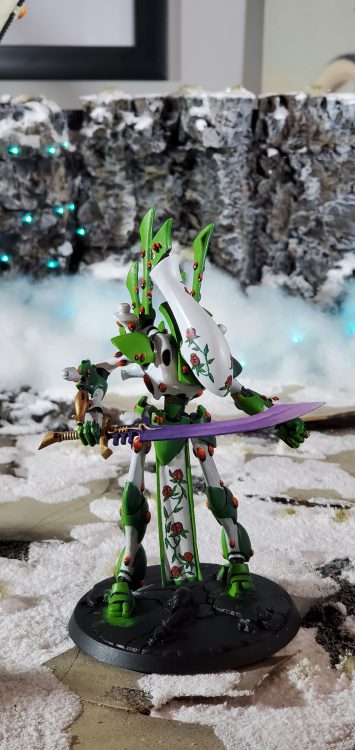
Our Thoughts
Boon: From a pure competitive standpoint, I think that this book is going to struggle to find its feet out of the gate and many players are going to end up losing in list construction. The army is hungry for CP which lends itself to a Battalion but there are premiums on nearly every unit and ability. The requisite character and troop choices are going to represent particular challenges to taking a battalion as players are forced to make concessions that feel more like taxes rather than reasoned trade-offs, and that feels bad. In terms of HQ’s players will be forced to account for what secondaries they’ll lean into and how it’ll impact their casters – will they need a second caster for psychic actions? Can they afford to take that Phoenix Lord or Autarch after? In the Troops role, the loss of Dire Avengers from the Troops category means that you’re without a reliable, flexible Troops unit that doesn’t cost a ton. Guardian blocks are expensive even at their minimum squad-size and will handicap the rest of the army if you are invested but aren’t building specifically for them which is a hard thing to say of a troops option. The cheapest option is going to be the Rangers, and they’ll fill most slots I expect – however I don’t believe they compare favorably to other troop options even within the Aeldari range (Drukhari Kabalites/Wyches/Wracks and Harlequin Troupes) which in many ways are far more flexible or purpose-driven. This wouldn’t be terrible if there was relief elsewhere in list construction, but unfortunately the Asuryani options are universally pricey.
At the table this book might be one of the more tactically challenging to play. Even if we set
aside for the moment the overtuned nature of both Tau and Custodes, this is going to be an army that can’t afford a turn of misplacement or bad dice because it will not have the redundancy or resiliency to weather the return fire. This is an army that will be very easy to overextend with due to its speed, but it will need to play extremely judiciously on the missions because each unit lost is going to be felt exponentially in the late game. A major form of reliability, non-psychic command phase boosts, ironically doesn’t support units that don’t want to be on the board during the command phase, as they need to be coming out of transports or reserves due to their lack of durability – units that do want to be on the board like War Walkers or heavier vehicles are generally not eligible for command phase or even many psychic buffs. It really feels like the book took a very late series of point increases or changes across the board that left it feeling thin overall.
Ultimately, there is a lot to like in this book, and there’s a lot of reason to think that it can throw out some very powerful combinations, but my assessment is that it’s going to be an army that really needs every trick to go off without a hitch to stay afloat. Individual data sheets are very good, but once you start bringing it all together you’re left with a feeling of “That’s it?” It’s possible there’s something here, particularly in the custom traits or mixed Harlequin/Craftworld options, that facilitate some very deadly combinations and tricks that keeps the book competitive – but I fear we’re on an uphill climb in this edition and certainly while Tau and Custodes remain oppressive.
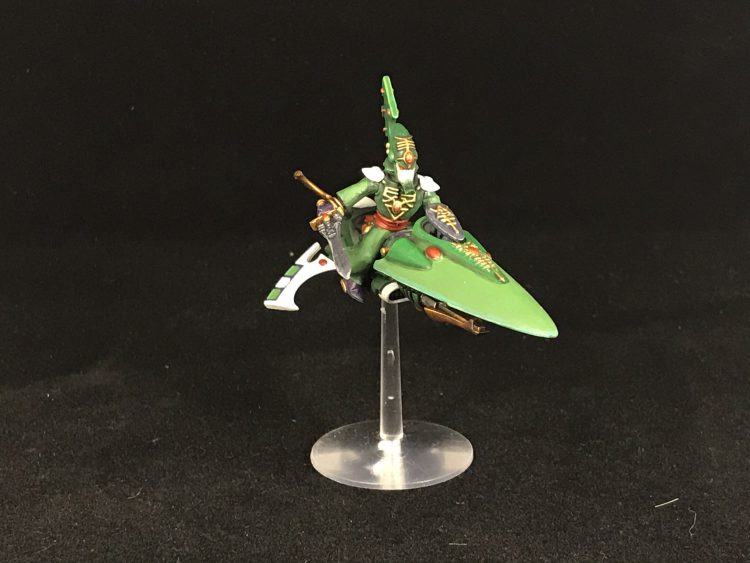
Wings: Yeah so we’re going to get murdered in the comments for this, because this book is coming in as easily the most hyped single tome of the entire edition, but this honestly doesn’t feel like it’s going to dominate the metagame out of the gate, and might actually end up faintly underperforming. I have never wanted to be wrong more on a review judgment call, because this is my favourite faction, and will happily take my lumps if I’m covering all-Asuryani top fours in a month’s time, but we’ve been building a tonne of lists with this book and the vast majority feel like they’re just not quite hitting the the power level needed to contend with the current metagame.
That’s not to say there’s nothing to like in this book, to be clear, a lot of stuff rules! Aspect Warriors feel suitably spicy, the tricks feel powerful as hell, and most of the big splashy units look like they’ll be exciting to play around with. I also really like the depth of integration with Harlequins, and it’s genuinely possible that the ease with which you can plug some gaps in a list with them might paper over some of the issues I’m about to hit. The Webway Gate is also unlike anything else we’ve seen in this Edition, and honestly really 8th either, and sets a new standard for how much a single unit can completely change up how the game plays for you. I am certainly expecting to have plenty of fun with this book, will certainly be hitting the tables with it, and have a bunch of ideas I want to try – but there’s a big caveat to that.
Trying to build lists with this book is a vastly more hostile experience than anything else recently, and as Boon mentioned the key culprit is the move of Dire Avengers from Troops to Elites, leaving the latter slot vastly overstuffed and the former pretty mediocre. The Asuryani end up as a faction where building a Battalion either forces you to take stuff you don’t really want, or massively commit to spending on Troops, eating badly into the rest of your army. The fact that everything else is pretty expensive too only compounds this, and when you finish your lists you definitely feel like you’ve been a bit short changed. That impression obviously is being skewed by the fact that the metagame is currently being dominated by two factions that get more stuff in their armies than they really should, but even compared to the factions a step down from them like Drukhari and Orks you really don’t have much breathing room.
There are five things in the book that might help push past that to be a powerhouse anyway. Automatic Saves from Strands of Fate are a huge defensive asset – as long as you roll some – and can provide tremendous alpha strike protection. Phantasm and Falcons provide great configurability in setup, letting you ensure you get the first crack at doing big damage and really exploit advanced deployment. Will of Asuryan meaning you can RND with one of your alpha units while also doing damage might mean lists don’t feel as short as they look. D-cannons are completely buck wild, and spamming them might create a skew build that’s really,really hard to beat. Finally, the Webway Gate is so completely different to what we’re used to that it might prove to be a nightmare to beat in the hands of a skilled player. Every list I’ve put together is leaning on some combination of these, and I’m going to do my level best to find the one that really sings.
Ultimately, this book has a huge number of things in it that I’m excited about, but the Battalion issue does tinge it a bit with bitterness, because it brings back the worst thing about playing Craftworlds in 8th, the Troop Tax. The Asuryani were powerful for the majority of 8th Edition, but the difficulty of putting together a really solid Troops core often forced them towards nightmare skew builds or souping in other factions, neither of which really sings for the true Elf appreciator. This book is going to be great fun, and hopefully in a month I’ll be laughing at what a fool I was, but after a string of books where it’s felt like the designers have gone through with a fine toothed comb to really push what they can do, there’s just a few too many things here that feel like they got the opposite treatment, and that’s probably going to constrain what options here really excel.
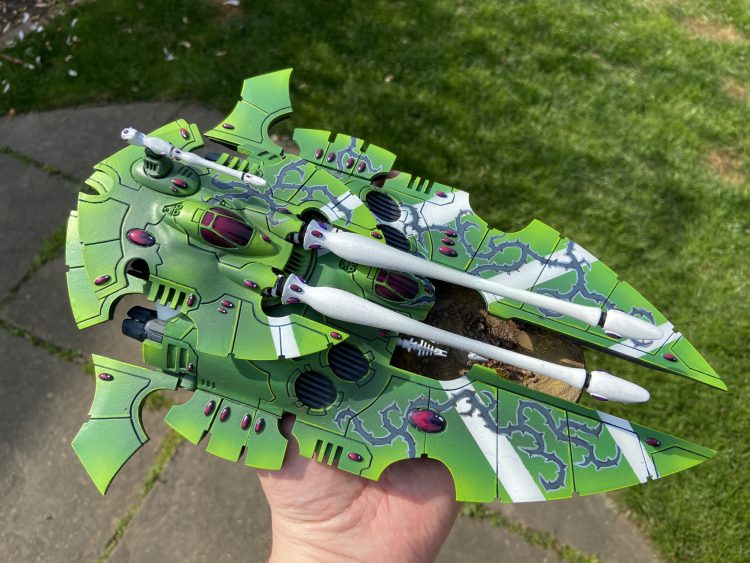
Army Lists
Wings
Biel-Tan is my first love, and I have not one but two lists using the Craftworld to show you – one that confronts the challenges of staying pure Asuryani head on, and one that gives into the sinister lure of clown town, and brings some Harlequins along for the ride.
Pure Biel-Tan
Biel-Tan Battalion
HQ
Farseer Skyrunner, Warlord, Seer of the Shifting Vector, Spiritstones of Anath’lan, Guide, Doom, Will of Asuryan – 120
Autarch Skyrunner, laser lance, Sunstorm – 100
No Slot
Warlock Skyrunner, Protect/Jinx – 60
Troops
Rangers, wireweave net – 70
Rangers, wireweave net – 70
Storm Guardians – 80
Elites
Dire Avengers x6, extra shuriken catapult, Stand Firm – 82
Howling Banshees x5, Cronescream, Mirrorswords, Piercing Strike – 105
Striking Scorpions x5, biting blade, Crushing Blow – 105
Wraithlord, ghostglaive, shuriken catapults, 2 shuriken cannons – 135
Fast Attack
Warp Spiders x5, powerblades, extra death spinner, Surprise Assault – 125
Windriders x6, shuriken catapults – 120
Shining Spears x5, Shimmershield, shuriken cannon, lightning attacks, star lance, Khaine’s Lance – 210
Heavy Support
3 Support Weapons with D-cannons – 195
Night Spinner – 140
Night Spinner – 140
Dedicated Transport
Wave Serpent, twin shuriken cannon – 140
1997pts, 10CP
Wings: This list is aimed primarily at launching brutal counterattacks. The Night Spinners and d-cannons make occupying space difficult for the opponents, and a few more sacrificial things like the lone Wraithlord and Wave Serpent can move onto objectives. As soon as the enemy join battle, it’s time to start applying brutal damage from the Spears and Warp Spiders, with the Windriders adding to the sheer weight of Shurikens while also ticking off Actions with Will of Asuryan. Dire Avengers out of the Serpent can pick up another quarter with RND trivially. Finally, the Scorpion and Banshee units are both tremendous trade-up threats that the opponent needs to constantly be wary of, with the Scorpions in particular pressuring where the opponent can afford to deploy their good stuff. If you roll up a few hit sixes on Strands turn one, then the Exarch can pop Wrath of the Shrines and take out an entire main battle tank with 10+ auto-wounding hits via automatic double-exploding 6s, which until people get used to just what he can do is going to give you plenty of trade-ups.
The list also makes sure to have a decent To The Last plan – you’re locked into taking it on the Spears if you want a full stack of them, but the second and third choices can be the D-cannons and one of the Spinners, which can be hard to reach, especially as you’ve got a squad of Storm Guardians purely for bodies to screen the Cannons from charges. My biggest concern with the list is whether the Spears turn out to be worth it – they’re very cool, but they’re also a huge investment as is, and I can absolutely believe you’d be better off cutting down to just a trio (MSUs are very nasty at this point) and buying a second Wraithlord or something – which would also make To The Last even better, as it would be on all the artillery.
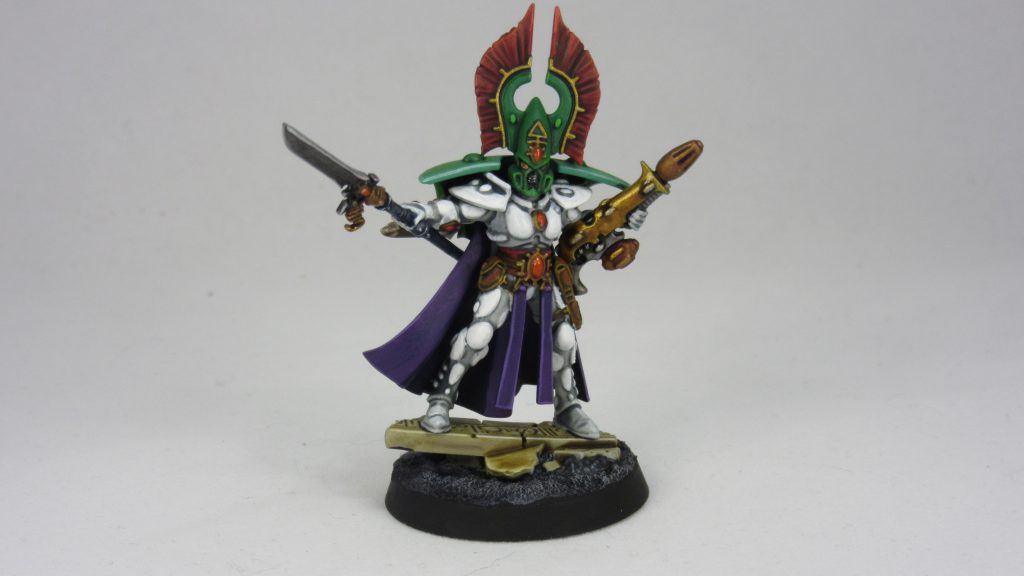
Biel-Tan and Harlequins
Light Saedath Patrol
HQ
Shadowseer, Warlord, Mirror of Minds, Fog of Dreams, Fractal Storm – 100
Troops
Troupe, harlequin’s kiss on lead player, 2 fusion pistols – 80
Troupe, harlequin’s kiss on lead player, 2 fusion pistols – 80
Dedicated Transport
Starweaver – 80
Starweaver – 80
Biel Tan Vanguard
HQ
Farseer Skyrunner, Seer of the Shifting Vector, Doom, Will of Asuryan – 120
Autarch Skyrunner, Natural Leader, laser lance, Sunstorm – 100
No Slot
Warlock, Protect/Jinx – 40
Elites
Dire Avengers x10, extra shuriken catapult – 120
Dire Avengers x6, extra shuriken catapult, Stand Firm – 82
Striking Scorpions x5, biting blade, Crushing Blow – 105
Striking Scorpions x5, biting blade – 90
Fire Dragons x6 – 138
Fast Attack
Windriders x6, shuriken catapults – 120
Shining Spears x5, shuriken cannon, lightning attacks, star lance – 205
Heavy Support
Falcon, two shuriken cannons – 150
Falcon, two shuriken cannons – 150
Dedicated Transport
Wave Serpent, twin bright lance – 160
2000pts, 7CP
Wings: Of the lists I’ve built so far this is the one I’m happiest with competitively. Bringing some Harlequins rather than trying to fill a Battalion, especially as the sticky, hard to deal with Light Saedath (more on that in their review), really helps give you a list where every unit actually feels like it’s pulling its weight and that you have enough things. The basic plan here has a lot of similarities with the first list, but you have better tools to go out and bait opponents into battle in the form of the harlequins, and the extra power play of double shooting with Dire Avengers if they lose a model in a Wave Serpent crash. Taking the Shadowseer as Warlord does lose you access to the Spiritstone, but as Biel Tan you can back-fill your Guide re-rolls for a Shining Spear alpha turn via Natural Leader, as you can still buy Craftworld extra traits with a Harlequin warlord, and can still use your free relic on Sunstorm.
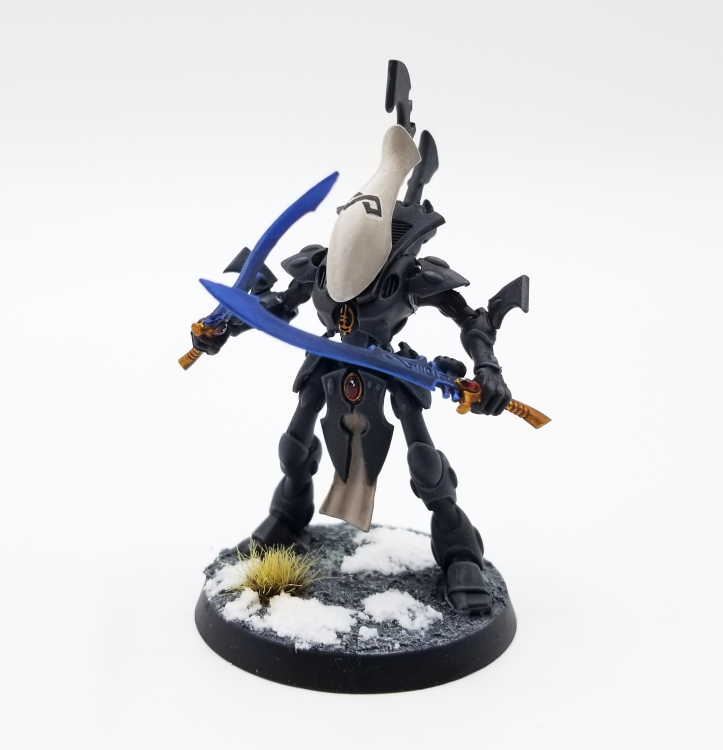
Pure Ulthwe
Boon: I wanted to lean into a list that facilitated Guardian blocks and Ulthwe is the sure bet here outside of custom selections.
HQ
Eldrad, Fate Reader (1 CP), Guide, Fortune, Fateful Divergence – 145
Farseer Skyrunner, Seer of the Shifting Vector, Ghosthelm, Doom, Executioner, Will of Asuryan – 120
Autarch Skyrunner, laser lance, Sunstorm (1 CP) – 100
Troops
Guardian Defenders x20, 1x Shuriken Cannon – 200
Guardian Defenders x20, 1x Shuriken Cannon – 200
Rangers – 65
Elites
Dire Avengers x5, extra shuriken catapult, Stand Firm – 70
Howling Banshees x5, Cronescream, Mirrorswords, Piercing Strike – 105
Striking Scorpions x5, biting blade, Crushing Blow – 105
Fast Attack
Windrider Jetbikes x5 – 100
Windrider Jetbikes x5 – 100
Warpspiders x6, Suprise Assault – 135
Heavy Support
Nightspinner – 140
Nightspinner – 140
D-Cannons x3 – 195
Fortification
Webway Gate – 80, 1CP
2000 Points, 9 CP
Leveraging the Webway Gate to reduce CP costs, the list relies on the classic double-drop Guardian blocks out of reserve. With the bevy of psychic support, boosted by Eldrad’s reliability and a shuriken-based Stratagems for +1 and exploding 6’s to hit, the Guardians can put out a fairly lethal barrage while being relatively resilient in their large, Fortune and Will of Asuryan blocks. Interestingly, whether out of the webway or the board edge, they’re equally effective here with their boosted range. Generally, the list wants to play around the mid-board, using the Nightspinners to threaten backfield objective holders and the D-Cannons to establish dominance on mid-field objectives – then surrounding this core with the utility hitters of the Aspect Shrines. The Windriders provide a mobile action unit in a pinch.
Wrap Up
That wraps up our thoughts on the Craftworlds section of the book, minus one particular craftworld and the enigmatic Harlequins. Of course, we’re covering those as well, and youc an find our take on Ynnari by following the link below.
Have any questions or feedback? Drop us a note in the comments below or email us at contact@goonhammer.com.


